Patch News – May 2017
May was quite an eventful month, we had baking hot days, storms with very heavy rain, and cows that came and went again. Unfortunately the cows were in the field when we had a couple of days of really intense rain and they appeared to have decided our patch was the best place to gather. It’s been churned up really badly and although they’ve now been moved to another field it will take quite a while for the patch to recover. Wonky Wiltshire send me this photo that illustrates the problem well, it ripped an undercarriage leg clean out of his Hurricane. The cows left us their usual ‘presents’ but this time it covered a large area of the patch completely. Catapult King’s Speedy has to be landed at speed to avoid tip stalling and he picked the wrong area to slide through. Yuk! The normally polite Gentleman Jim commented that it was a crap landing!
The cows left us their usual ‘presents’ but this time it covered a large area of the patch completely. Catapult King’s Speedy has to be landed at speed to avoid tip stalling and he picked the wrong area to slide through. Yuk! The normally polite Gentleman Jim commented that it was a crap landing!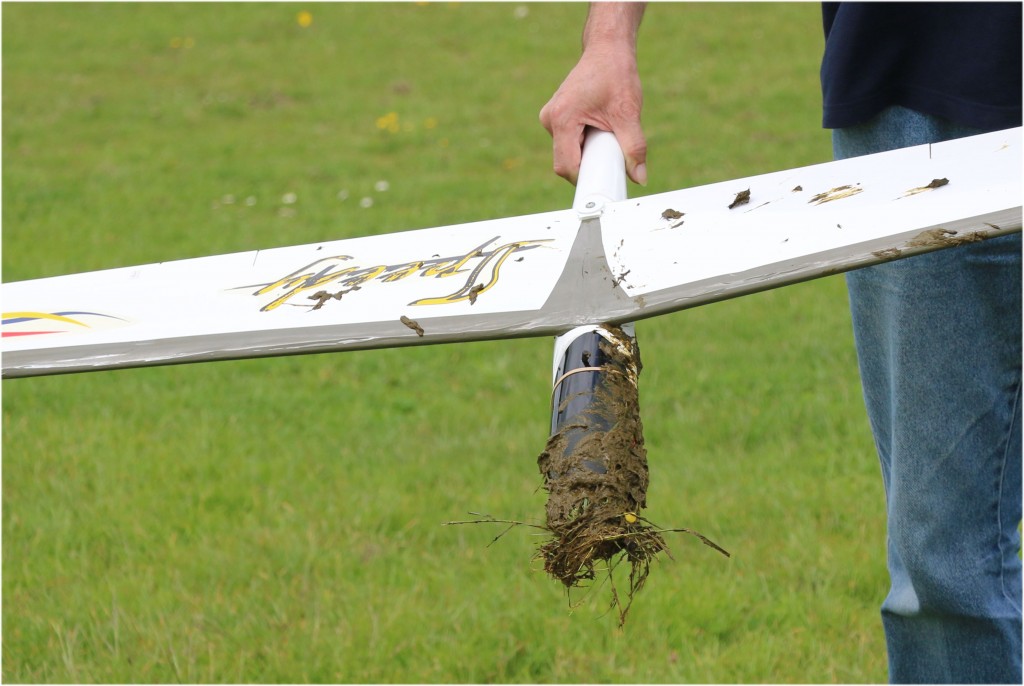 There were several new models that had their first flights during May, so I’ve got plenty to talk about. First up is Tony Neil’s new Tundra which is yet another model that’s produced by HobbyKing.
There were several new models that had their first flights during May, so I’ve got plenty to talk about. First up is Tony Neil’s new Tundra which is yet another model that’s produced by HobbyKing.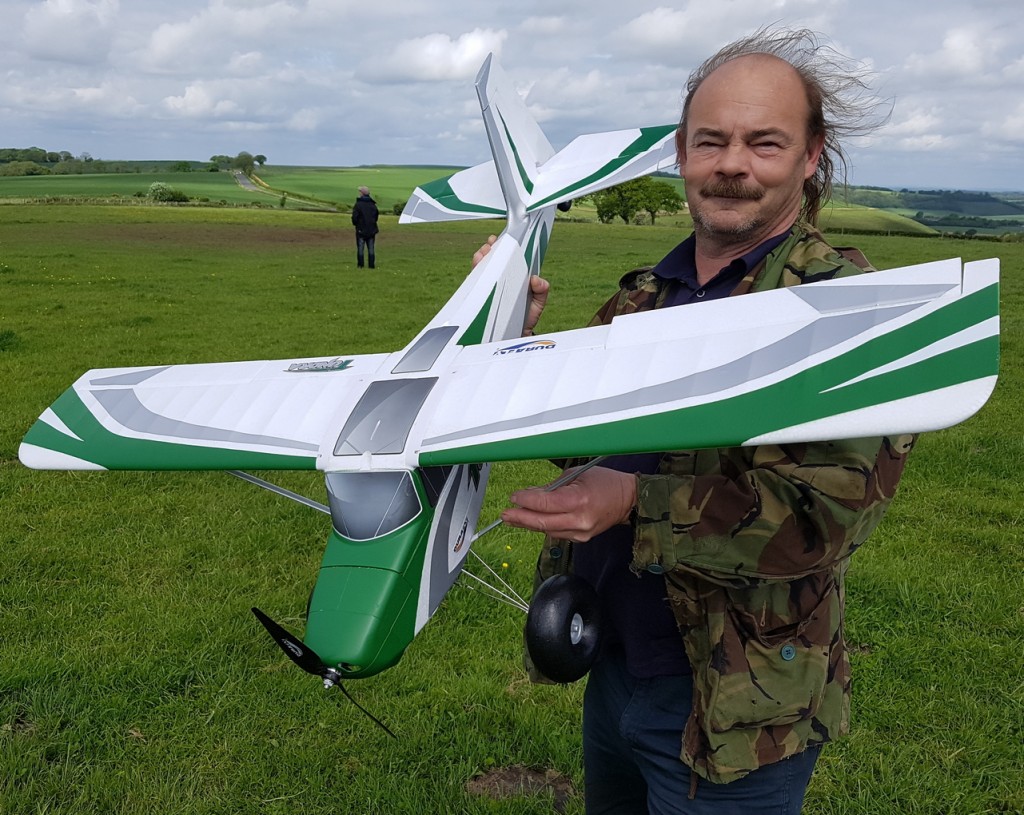 He spotted the Tundras were in one of their sales at a knockdown price and immediately snapped one up. It’s a Plug’n’Fly one so comes complete with everything, a 3636-950Kv motor, a 40A esc, the prop, 6 servos, flaps, and even floats in case you want to try flying off water. Tony said assembling the undercarriage was the biggest job.
He spotted the Tundras were in one of their sales at a knockdown price and immediately snapped one up. It’s a Plug’n’Fly one so comes complete with everything, a 3636-950Kv motor, a 40A esc, the prop, 6 servos, flaps, and even floats in case you want to try flying off water. Tony said assembling the undercarriage was the biggest job.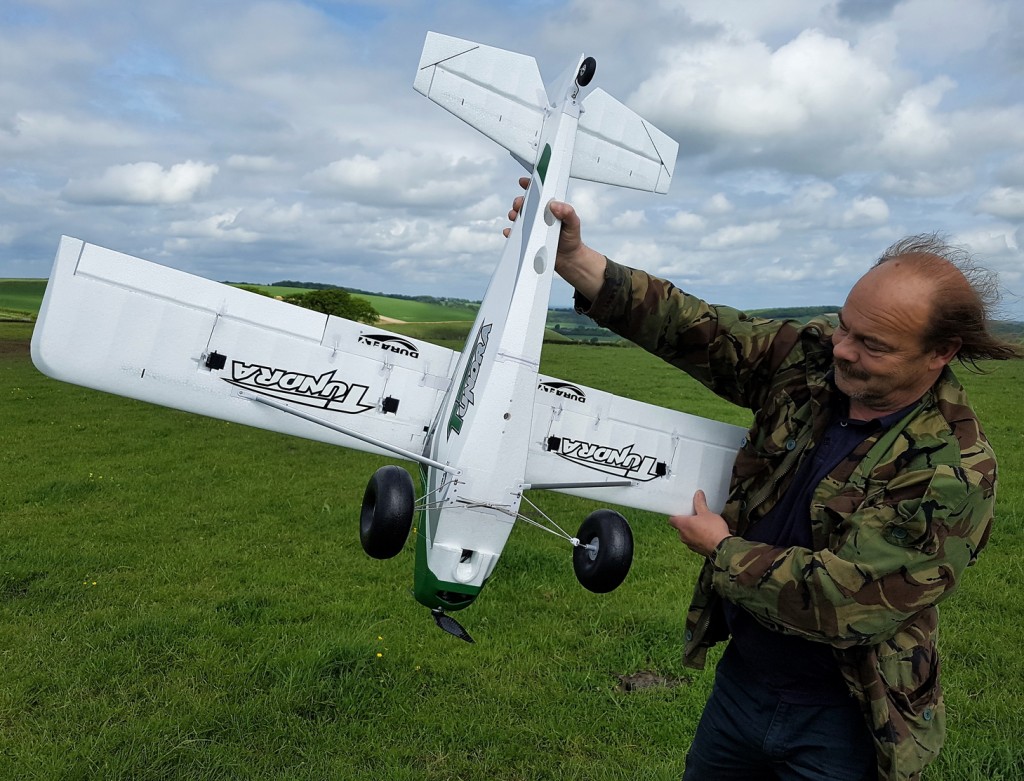
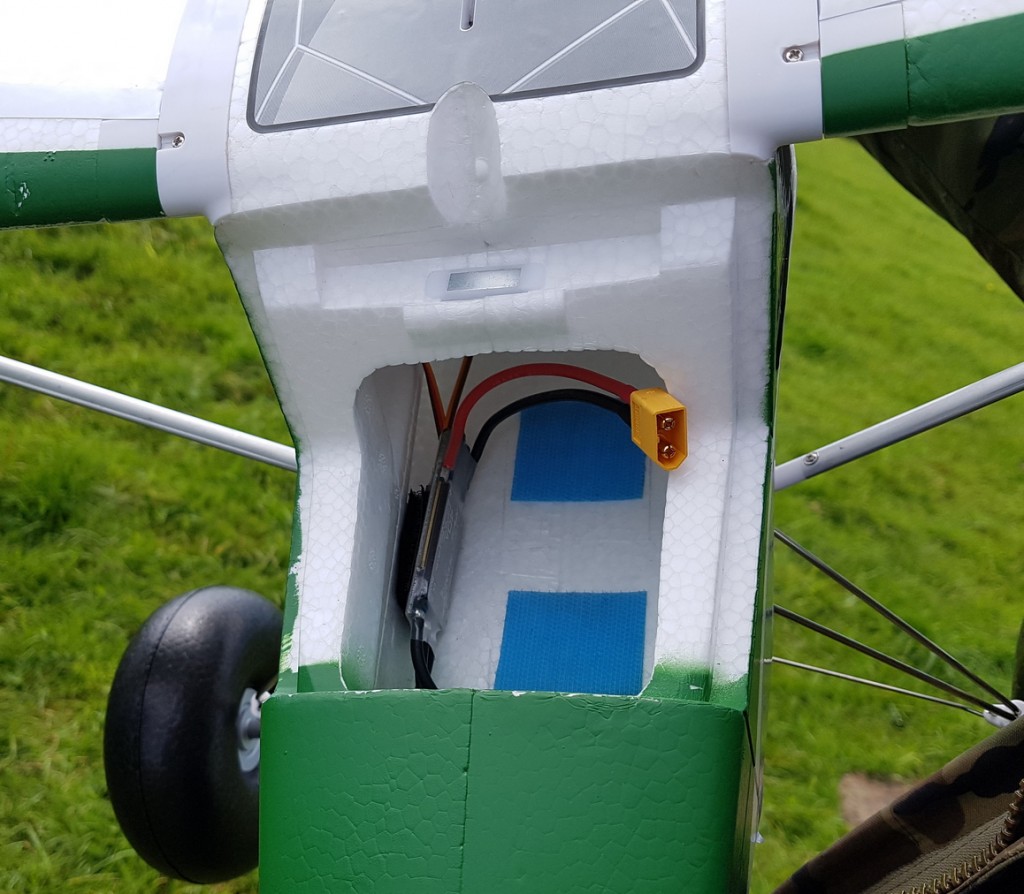 Tundras are 1300mm (51”) span so a decent size, plenty of space for a variety of batteries, and they look like a lot of fun. I’ve only seen Tony have one flight so far but it looked good and performed really well.
Tundras are 1300mm (51”) span so a decent size, plenty of space for a variety of batteries, and they look like a lot of fun. I’ve only seen Tony have one flight so far but it looked good and performed really well.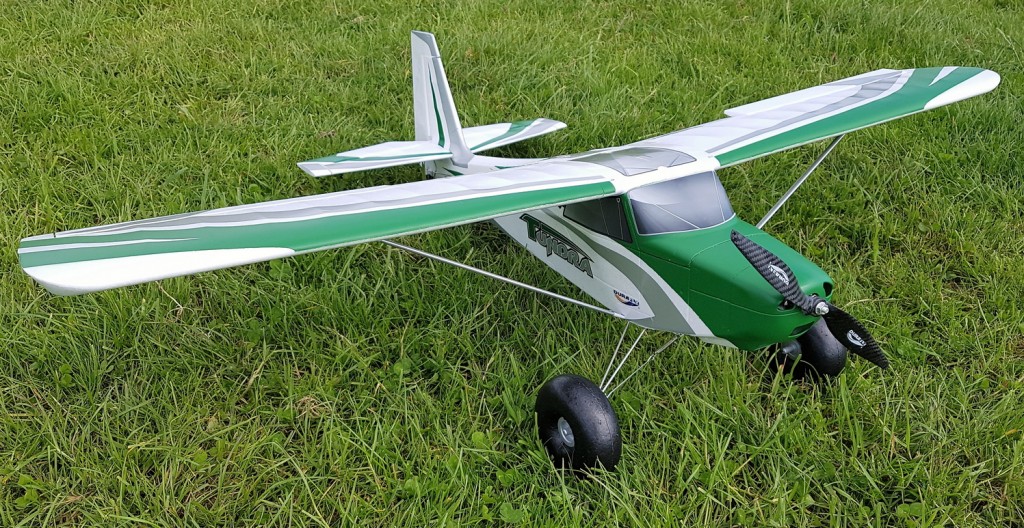 You can see some of that first flight in this month’s video at the end of Patch News.
You can see some of that first flight in this month’s video at the end of Patch News.
Last month I featured Dougal Entendre’s new Ghost Rider 50 when he’d said he may change the motor as it sounded pretty rough. Well he’s now changed it for a Turnigy 3542/6 1000Kv but initially found it was very noisy, he reckoned it sounded like a 40 I/C engine!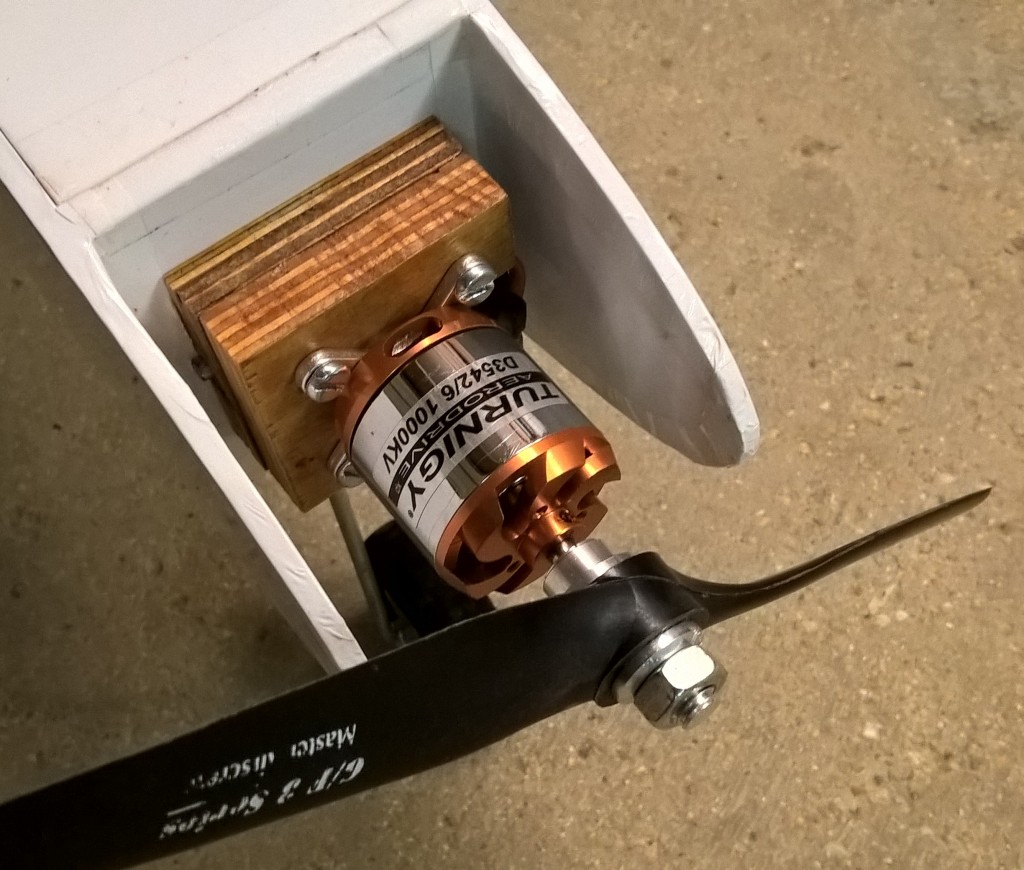 However, at the suggestion of 1066, he then tried it without the spinner and the problem was immediately solved. So if you have a noisy model try removing the spinner, it may just make the difference. Some of the cheap plastic ones can be well out of balance, it’s not just props that can produce vibration.
However, at the suggestion of 1066, he then tried it without the spinner and the problem was immediately solved. So if you have a noisy model try removing the spinner, it may just make the difference. Some of the cheap plastic ones can be well out of balance, it’s not just props that can produce vibration.
While I’m on the subject of Dougal, he has become the latest member of the Stool Club. He found this one kicking around his garage and said it’s years old and has become a bit stiff to unfold, or as he put it, ‘a nice firm stool’!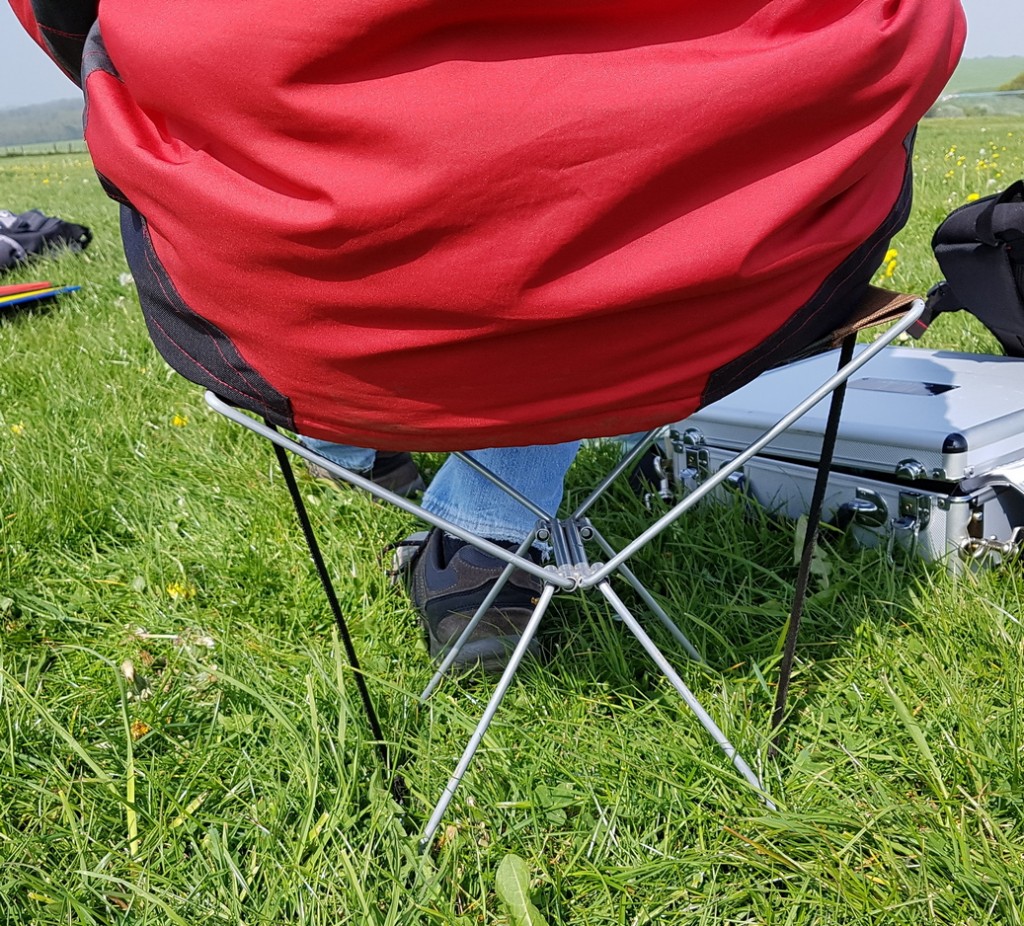 That should get the comments flying again…
That should get the comments flying again…
Basher Bob has been at it again. No, not mid-airs this time, but he did manage to knock the nose off his Wot-4 when he cartwheeled it on landing. I’d blame the state of the patch Basher.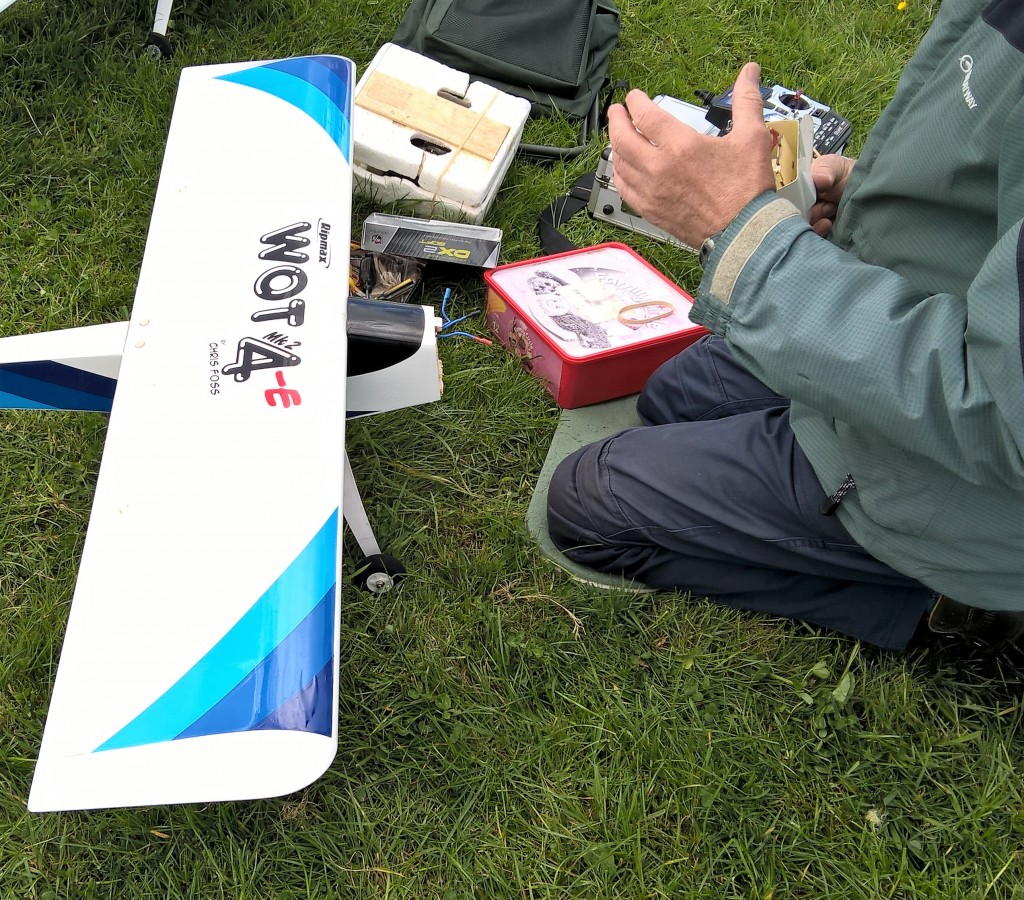 Fortunately it was a clean break so it was easily mended and soon flying again.
Fortunately it was a clean break so it was easily mended and soon flying again.
One day in May as I was driving down the track I spotted this in the field: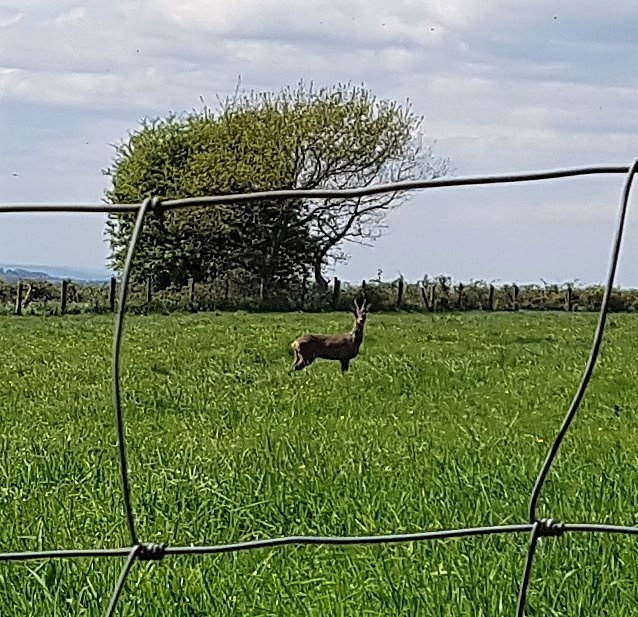 I’ve seen a few hares over the years but never a deer in almost 40 years of flying there.
I’ve seen a few hares over the years but never a deer in almost 40 years of flying there.
Woody has bought himself a nice new Edge 540T. Rather like Tony’s Tundra, Woody spotted the Edge on sale at a knockdown price on the HobbyKing site and hit the Buy button. We’ll have no ‘Cor, look at that pile of dung’ comments thank you!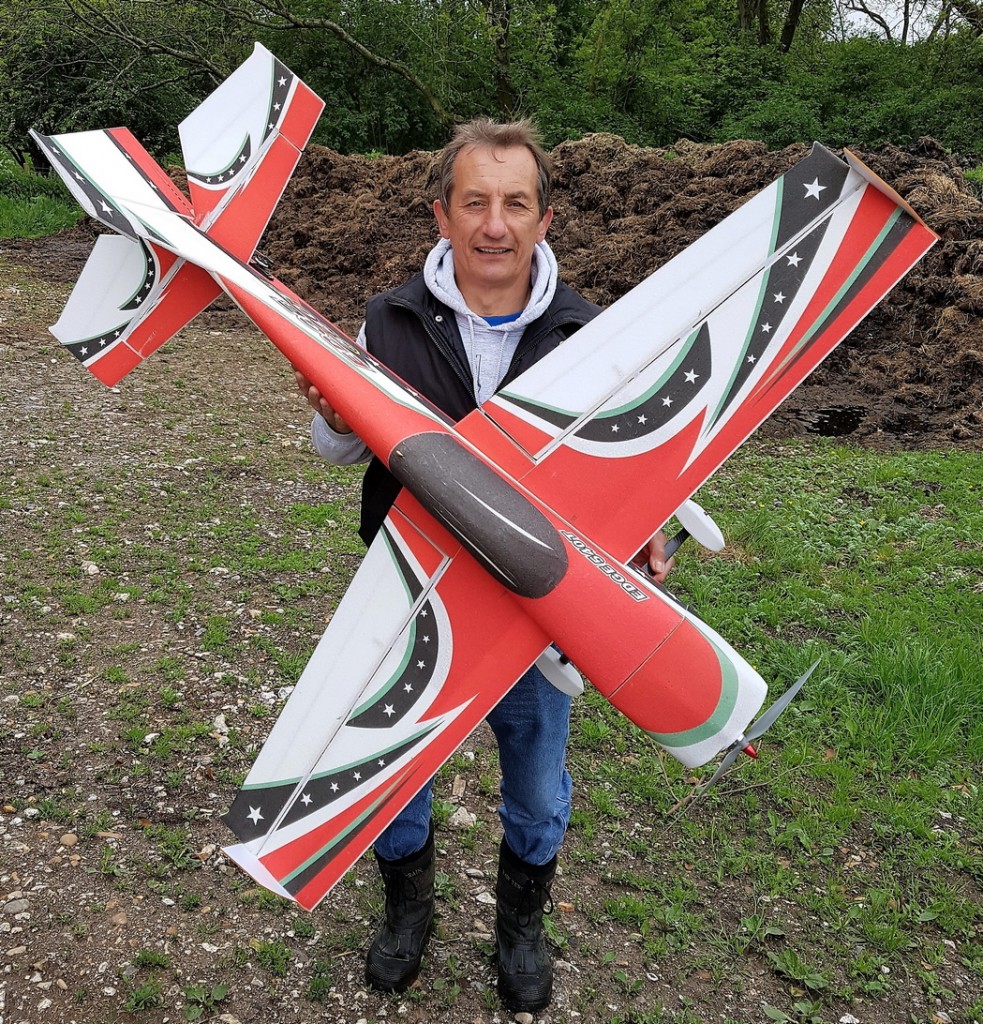 It’s one of the larger EPP/light ply ones at 1430mm span and needs a 4 or 5 cell lipo, with Woody opting to use some 5 cell 4500mAh packs he already has. It comes as airframe only and Woody has fitted a Turnigy Aerodrive SK4250-500kv motor driving a 14×7 prop. The speed controller is an 80A Turnigy Plush and the servos are metal geared Corona DV339HVs. It looks like there’s plenty of room to squeeze the lipo in somewhere.
It’s one of the larger EPP/light ply ones at 1430mm span and needs a 4 or 5 cell lipo, with Woody opting to use some 5 cell 4500mAh packs he already has. It comes as airframe only and Woody has fitted a Turnigy Aerodrive SK4250-500kv motor driving a 14×7 prop. The speed controller is an 80A Turnigy Plush and the servos are metal geared Corona DV339HVs. It looks like there’s plenty of room to squeeze the lipo in somewhere.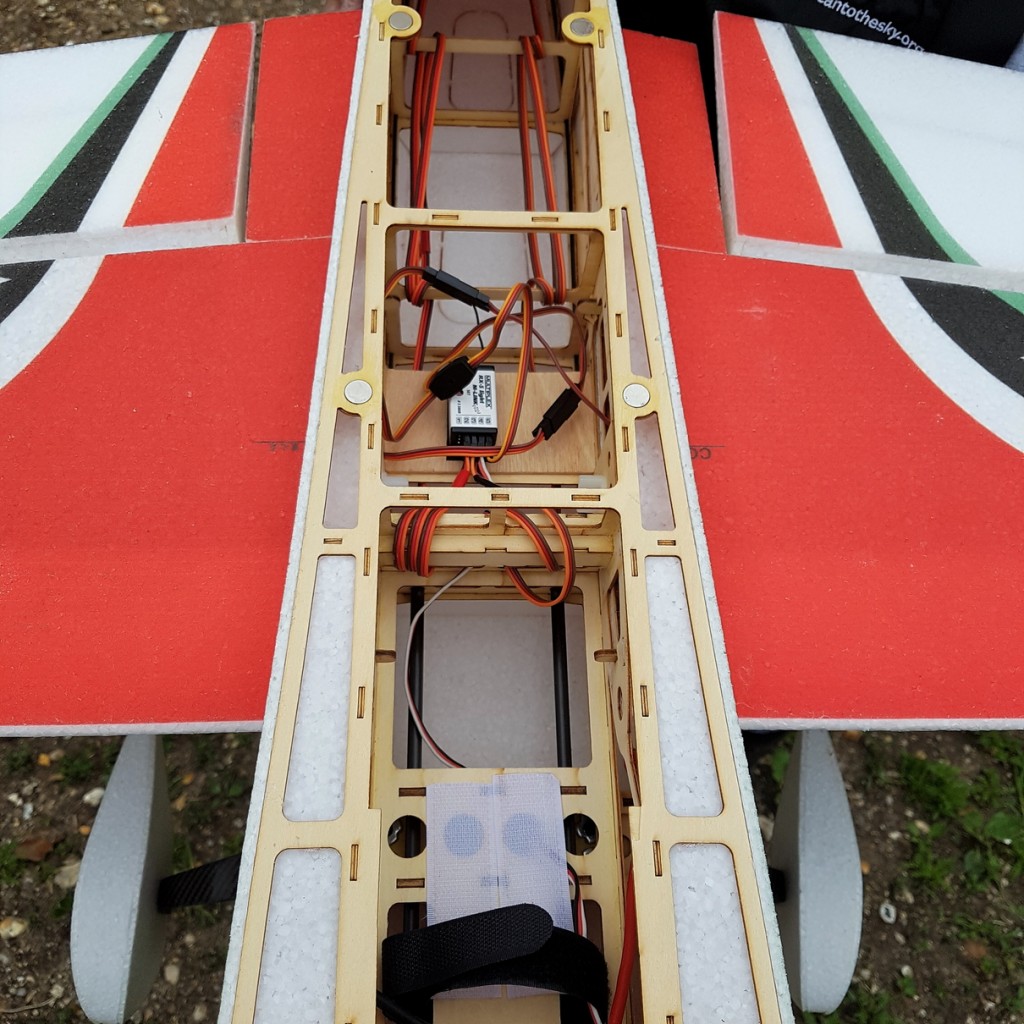
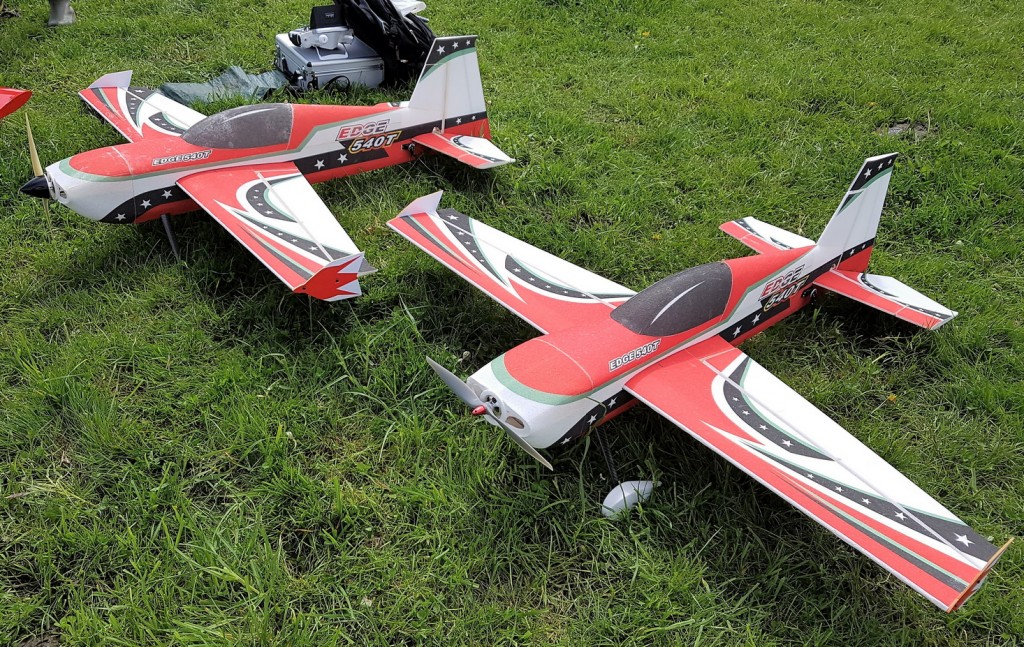 And then there were two. Dougal did the first take-off and trimming as he owns an identical model and was happy to report that it was just about perfect. Woody took the controls after a couple of minutes and headed for the stratosphere as usual! Better safe than sorry Woody, three mistakes high is never a bad thing.
And then there were two. Dougal did the first take-off and trimming as he owns an identical model and was happy to report that it was just about perfect. Woody took the controls after a couple of minutes and headed for the stratosphere as usual! Better safe than sorry Woody, three mistakes high is never a bad thing.
It’s just as well that he’s bought a new model, as Woody recently managed to pull the wings off his Ugly Stick at an altitude of about 200 feet. As you can imagine the end result wasn’t pretty but to be fair it really wasn’t Woody’s fault so I declined to take any photos.
Catapult King wasn’t so kind to me when I buried my Wingnetic the other day. I have to admit that it was totally my own fault, I got carried away with multiple twinkle rolls and I had trouble deciding quite when to release the aileron. When I eventually did, I pulled full up only to realise that the plane was inverted!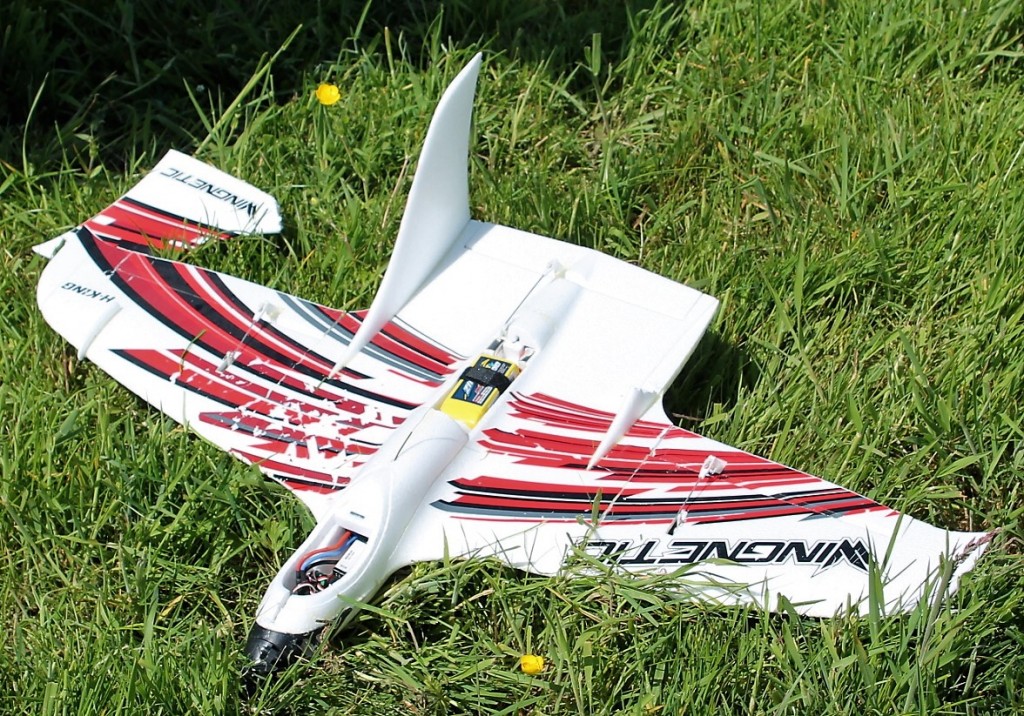 It went in flat out from about 40 feet and I was amazed at how little damage there was. It was soon repaired and is now flying again…rather more slowly and carefully!
It went in flat out from about 40 feet and I was amazed at how little damage there was. It was soon repaired and is now flying again…rather more slowly and carefully!
Most of you will know by now that Doreen and I flew to Stuttgart in Germany in mid-May to visit the Multiplex Airshow at Bruchsal. I won’t bore you all any more about it but if you’d like to see the official Multiplex video just CLICK HERE. The Squire snapped this photo of me in all the Multiplex clothing I bought at the show.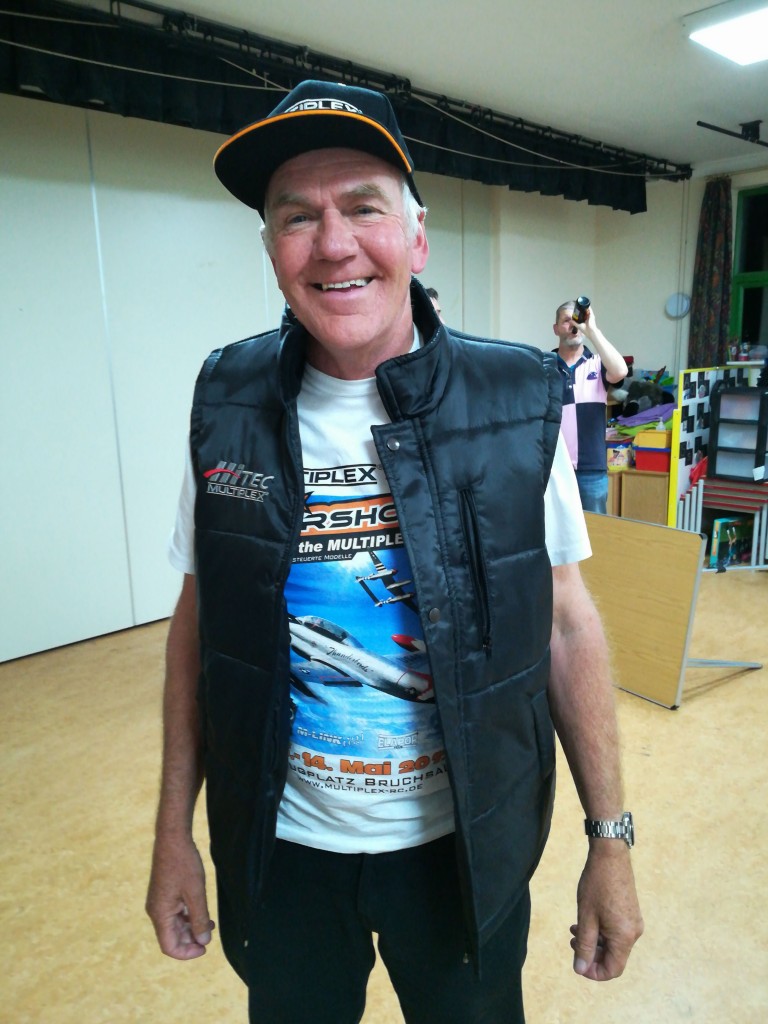 I might look a prat but notice he also caught the club drunk in the background!
I might look a prat but notice he also caught the club drunk in the background!
Some of us flew gliders from the lower field (to avoid the bullocks) one Friday afternoon when the weather was turning stormy. I took two photos, one facing south and the other facing north.
 The storm clouds provided a lot of lift and my glider soon became a tiny dot so I spun it back down to a more manageable height. I was aware that the transmitter was speaking my altitude but was too busy straining to see the dot to pay too much attention. When I landed I photographed the screen showing the maximum altitude reached.
The storm clouds provided a lot of lift and my glider soon became a tiny dot so I spun it back down to a more manageable height. I was aware that the transmitter was speaking my altitude but was too busy straining to see the dot to pay too much attention. When I landed I photographed the screen showing the maximum altitude reached.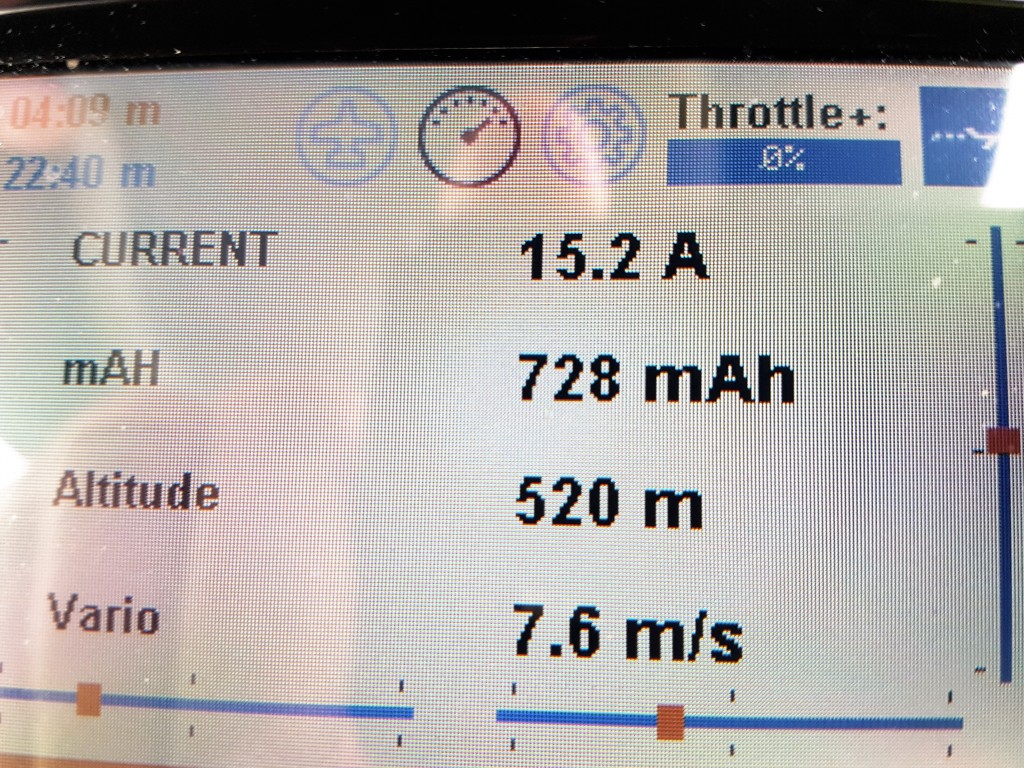 520 metres is 1706 feet, certainly the highest I’ve flown since I bought that system. By the way, as we are not in controlled airspace and the model is not a ‘large’ model I didn’t break any rules, we are not height restricted.
520 metres is 1706 feet, certainly the highest I’ve flown since I bought that system. By the way, as we are not in controlled airspace and the model is not a ‘large’ model I didn’t break any rules, we are not height restricted.
Terribull has been flying an uprated version of his Weekender recently having built a new wing for it.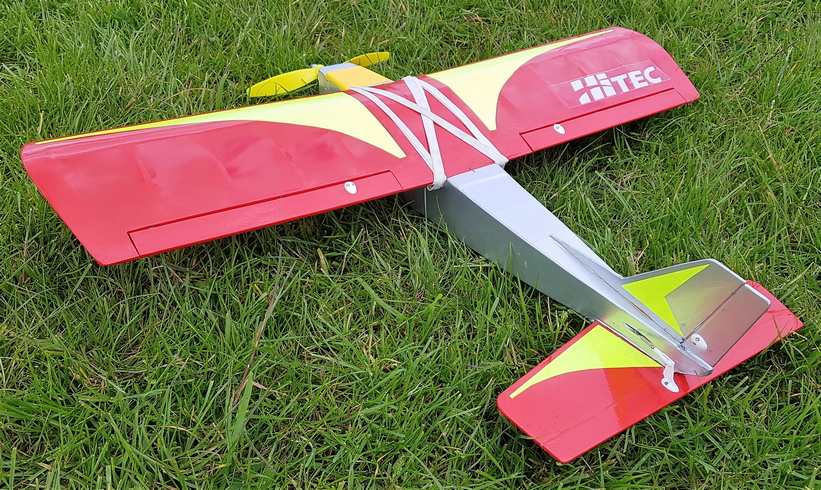 The original 3 channel version flew well enough but Terribull decided it would be even better with the full 4 channels so he built a new wing without any dihedral and added ailerons. The model flew perfectly well with the new wing but it looked a bit strange, or in Terry’s words ‘horrible’. Shouldn’t that have been ‘terrible’? Anyway, he built yet another wing, they only take a couple of days apparently, but this time he added ¼” dihedral under each tip.
The original 3 channel version flew well enough but Terribull decided it would be even better with the full 4 channels so he built a new wing without any dihedral and added ailerons. The model flew perfectly well with the new wing but it looked a bit strange, or in Terry’s words ‘horrible’. Shouldn’t that have been ‘terrible’? Anyway, he built yet another wing, they only take a couple of days apparently, but this time he added ¼” dihedral under each tip.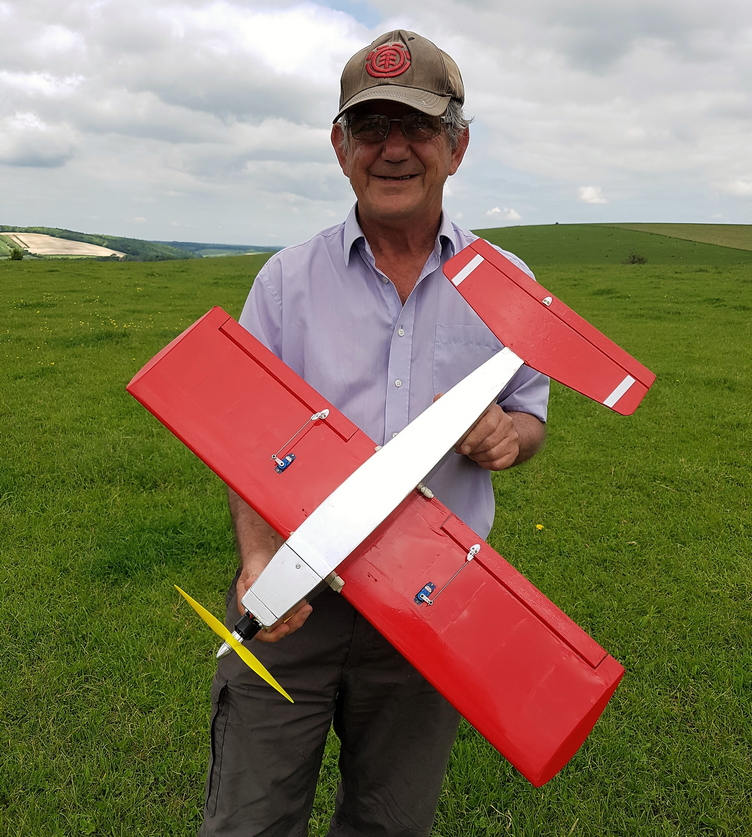 With this wing the model looks much better, flies extremely well, and Terribull declared it to be a success. He is now thinking of producing a few kits of the model so if you’d like to build one for yourself speak to Terribull.
With this wing the model looks much better, flies extremely well, and Terribull declared it to be a success. He is now thinking of producing a few kits of the model so if you’d like to build one for yourself speak to Terribull.
Dougal sent me this pic he took of me and said it looks as if I’m holding the transmitter upside down. It’s the future Dougal, the Multiplex future! The new transmitters have ‘ IOAT (Integrated Optimised Antenna Technology) an integral aerial with enhanced radiation pattern, optimised for model control, double the signal density transmitted to the model, offering a significant enhancement in security.’ Yes, I must admit they do look a bit odd at first but you soon get used to them. Captain Slow was obviously impressed by mine as he has now sold almost all of his Spektrum gear and bought a new Cockpit SX 9 identical to mine. It performs perfectly but unfortunately it refuses to accept a charge and has to be returned to Lindinger in Austria. OK, just to keep you Spektrum guys happy I’ll say it… Bloody Multiplex…!
Yes, I must admit they do look a bit odd at first but you soon get used to them. Captain Slow was obviously impressed by mine as he has now sold almost all of his Spektrum gear and bought a new Cockpit SX 9 identical to mine. It performs perfectly but unfortunately it refuses to accept a charge and has to be returned to Lindinger in Austria. OK, just to keep you Spektrum guys happy I’ll say it… Bloody Multiplex…!
Last month I included a photo of Cream Egg shaking my hand having passed his ‘A’ certificate. The actual certificate is normally presented by the Chairman at a club meeting but in this case some pillock (me) forgot to take the certificate along to the meeting. So, a little late and in the wrong place, here is Cream Egg being presented with his certificate at the field by Vice-Chairman Dougal Entendre. Well done Mike.
Well done Mike.
Gorgeous Gary has built a gorgeous new model, a Black Horse Midget Mustang. This is what the Black Horse website says about it: Modelled on one of the most famous post war racing aircraft, the Black Horse Midget Mustang EP will turn heads wherever she flies. That stunning red and yellow colour scheme is both pretty and functional by making visibility good at most attitudes. Black Horse also produce a larger version.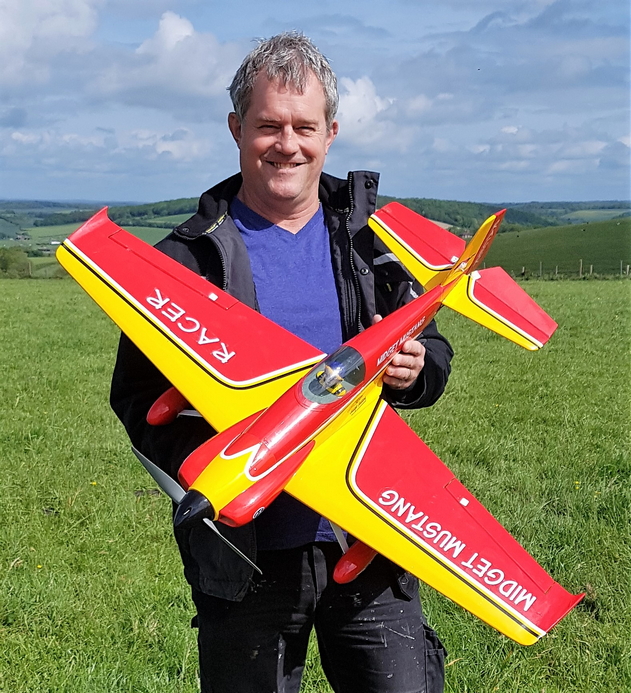 It certainly looks fantastic, a really pretty little model. I emailed Gary to request details about the powertrain and the reply came back “Sat in 29 degrees centigrade with a cold beer, back Friday”! So I don’t have any details of the powertrain other than that it has an OS electric motor and flies on a 3 cell lipo. The model is 1000mm span so isn’t big and, as you’d expect from scale model of a racing aircraft, it’s quite quick.
It certainly looks fantastic, a really pretty little model. I emailed Gary to request details about the powertrain and the reply came back “Sat in 29 degrees centigrade with a cold beer, back Friday”! So I don’t have any details of the powertrain other than that it has an OS electric motor and flies on a 3 cell lipo. The model is 1000mm span so isn’t big and, as you’d expect from scale model of a racing aircraft, it’s quite quick.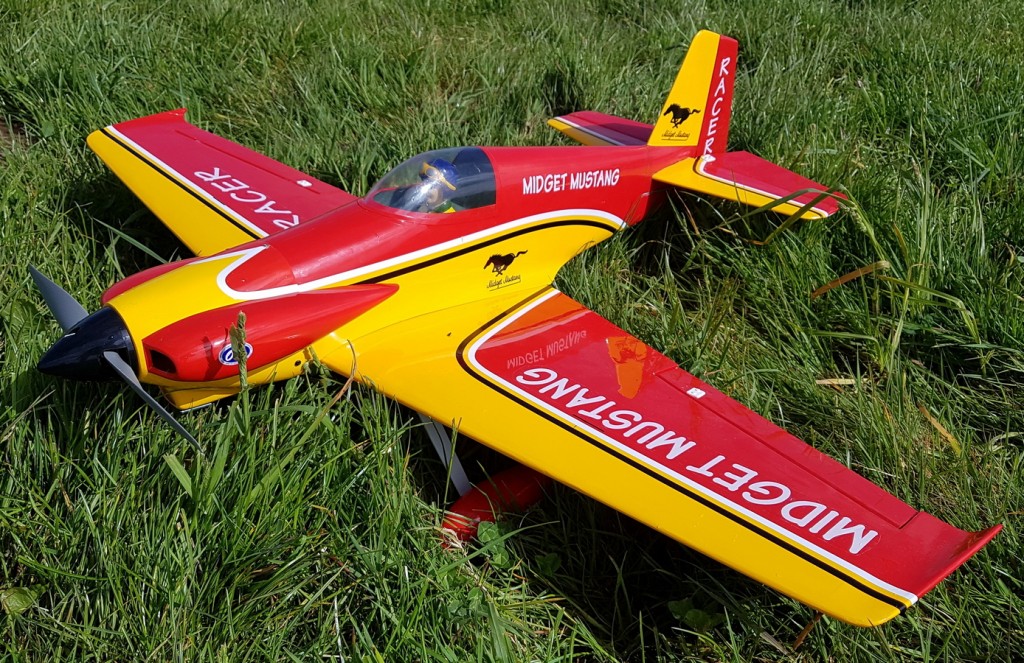
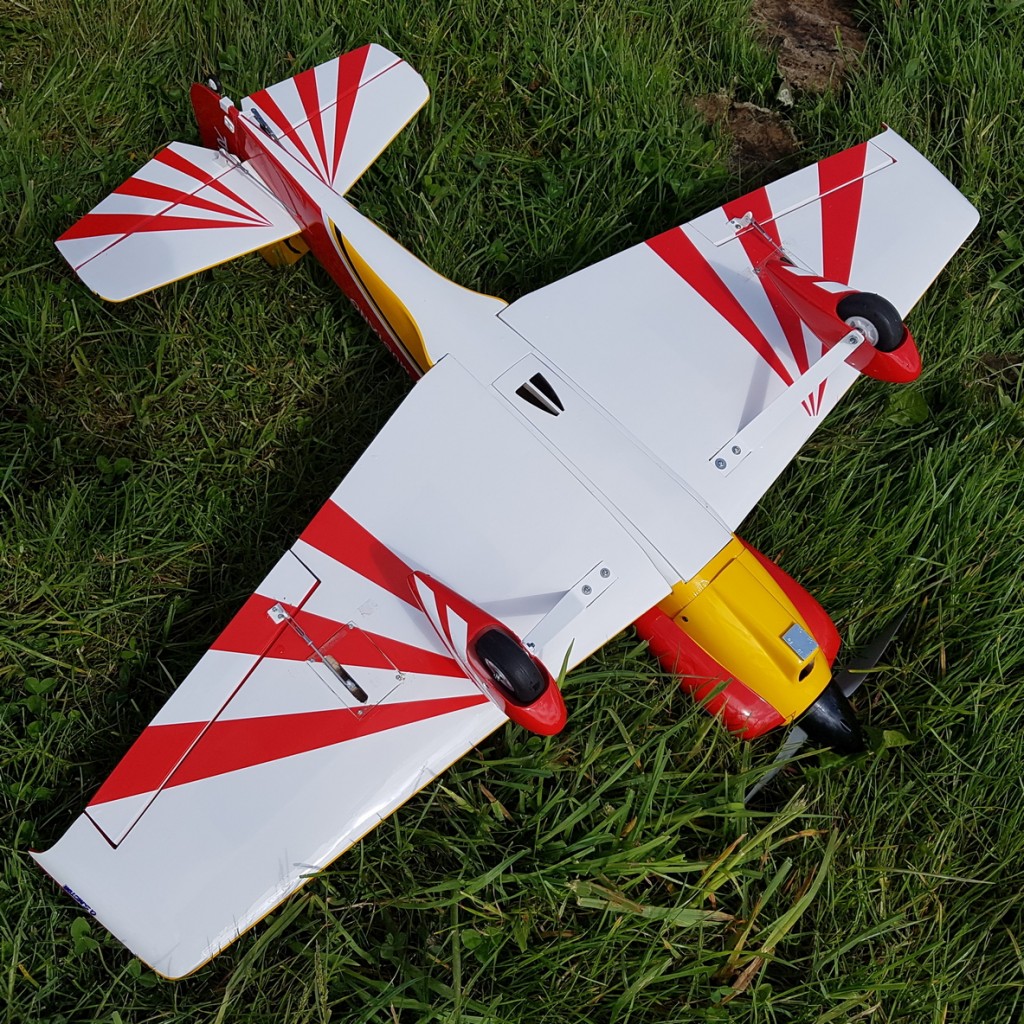 Sadly Gary’s turned out to be very twitchy and although I thought he’d got the better of it, the first flight ended in disaster when it was time to land. I hope he repairs it, the damage wasn’t too bad and it looked superb in the air as you can see in this month’s video.
Sadly Gary’s turned out to be very twitchy and although I thought he’d got the better of it, the first flight ended in disaster when it was time to land. I hope he repairs it, the damage wasn’t too bad and it looked superb in the air as you can see in this month’s video.
Time for a couple of ‘golden oldie’ photos now, firstly our President Don Eades with what at the time was his latest pattern ship, and secondly OMG look at those shorts, it’s Stanley Knife!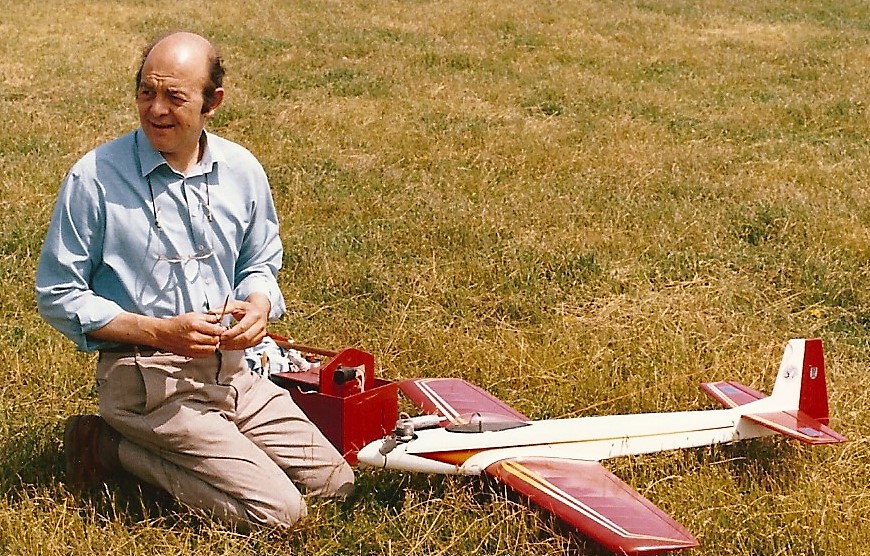
 Dougal Entendre tried to enhance his prop hanging skills last weekend by adding an old helicopter gyro to his Hummer. He linked it to the ailerons with the idea that it would be one less thing to worry about when prop hanging but apparently 1066 said he thought Dougal was better without it!
Dougal Entendre tried to enhance his prop hanging skills last weekend by adding an old helicopter gyro to his Hummer. He linked it to the ailerons with the idea that it would be one less thing to worry about when prop hanging but apparently 1066 said he thought Dougal was better without it!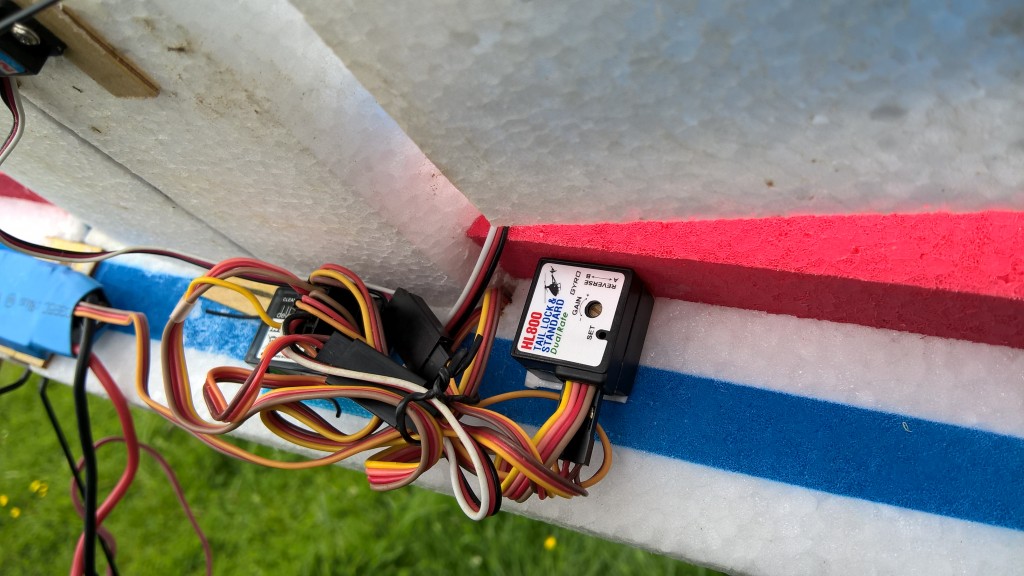 Nice neat wiring there Dougal. Personally I would have thought the way to go would be to add it to the rudder but with the gyro mounted so that it controlled the rudder when the model was vertical? I’ll have to think about how to do that, if I figure it out I might try it on my own Hummer. Watch this crash space.
Nice neat wiring there Dougal. Personally I would have thought the way to go would be to add it to the rudder but with the gyro mounted so that it controlled the rudder when the model was vertical? I’ll have to think about how to do that, if I figure it out I might try it on my own Hummer. Watch this crash space.
The last new model that I spotted during May was Gentleman Jim’s extremely nice new Pepperpot, a 1245mm (49”) span sports model produced by Phoenix Models.
 This is from the Phoenix Model Products website: The Pepperpot is a 4/5 channel stylish electric power sports aerobatic model that has a spritely performance. With a typical 4/500w 3542 size motor and using 3S 22/2700mA lipos the Pepperpot is both a delight to fly and build and will attract complements on both fronts. The all wood easy build construction follows the now well proven path of other models in our range in that it incorporates a fully sheeted built-up wing with a comprehensive collection of cut part and accessories.
This is from the Phoenix Model Products website: The Pepperpot is a 4/5 channel stylish electric power sports aerobatic model that has a spritely performance. With a typical 4/500w 3542 size motor and using 3S 22/2700mA lipos the Pepperpot is both a delight to fly and build and will attract complements on both fronts. The all wood easy build construction follows the now well proven path of other models in our range in that it incorporates a fully sheeted built-up wing with a comprehensive collection of cut part and accessories.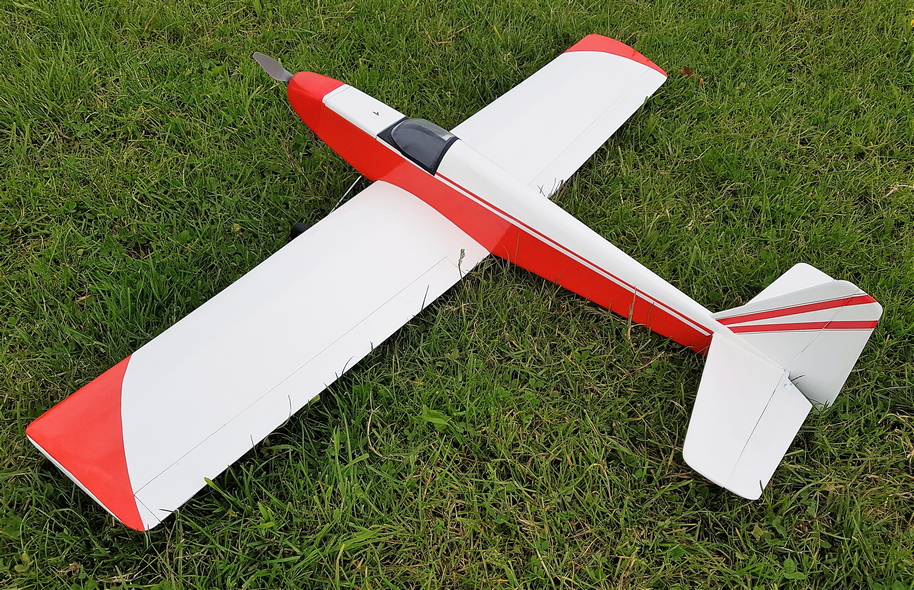 Jim says it’s definitely a ‘builders’ model and that is just what Stan Yeo of Phoenix intended. Jim has fitted it with a 3542 1250Kv motor, a 60A ESC, 9×6 Prop and a 2200mAh 3 cell lipo. He has made a very nice job of both the build and the covering and has finished up with a very pretty model. I was asked to do the first flight and am happy to report that the model was one of those that immediately felt right. We took-off and landed several times while we played around with the rates and expo a bit and discovered that it uses very little power from the battery.
Jim says it’s definitely a ‘builders’ model and that is just what Stan Yeo of Phoenix intended. Jim has fitted it with a 3542 1250Kv motor, a 60A ESC, 9×6 Prop and a 2200mAh 3 cell lipo. He has made a very nice job of both the build and the covering and has finished up with a very pretty model. I was asked to do the first flight and am happy to report that the model was one of those that immediately felt right. We took-off and landed several times while we played around with the rates and expo a bit and discovered that it uses very little power from the battery.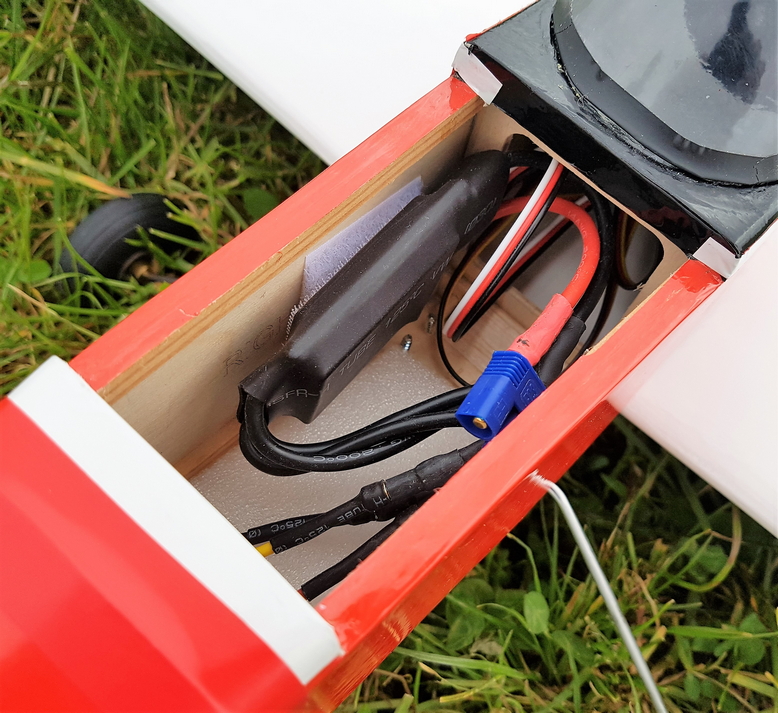 It really is a nice flier, loads of power and fully aerobatic but equally happy stooging around at less than half throttle and flight times of around ten minutes are easy possible.
It really is a nice flier, loads of power and fully aerobatic but equally happy stooging around at less than half throttle and flight times of around ten minutes are easy possible.
Now for a few assorted photos from Catapult King and Kryten, thanks chaps: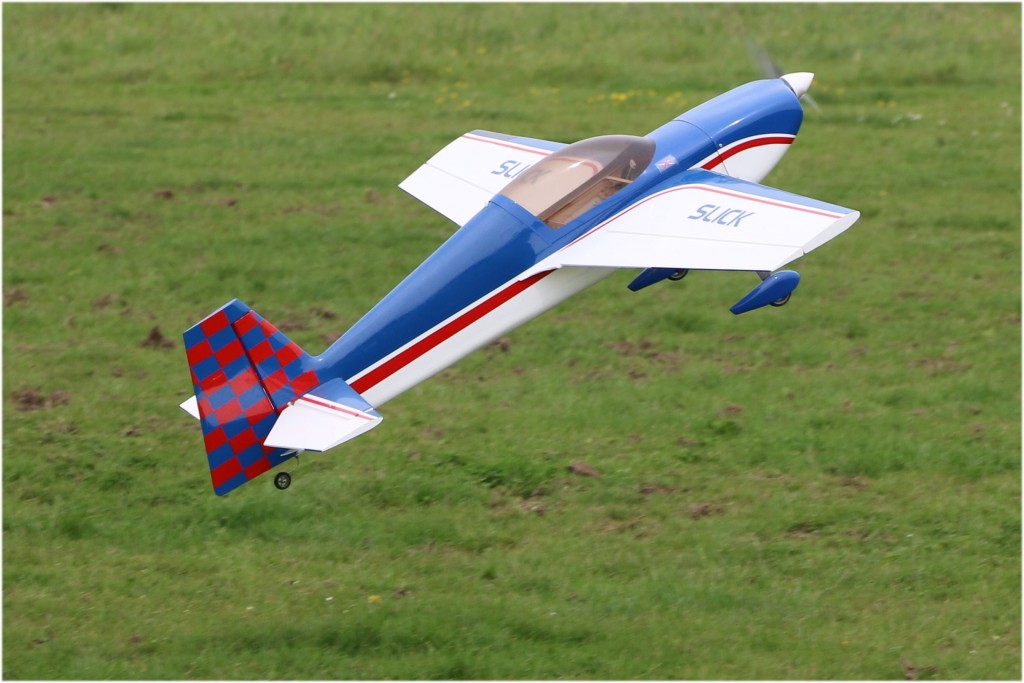
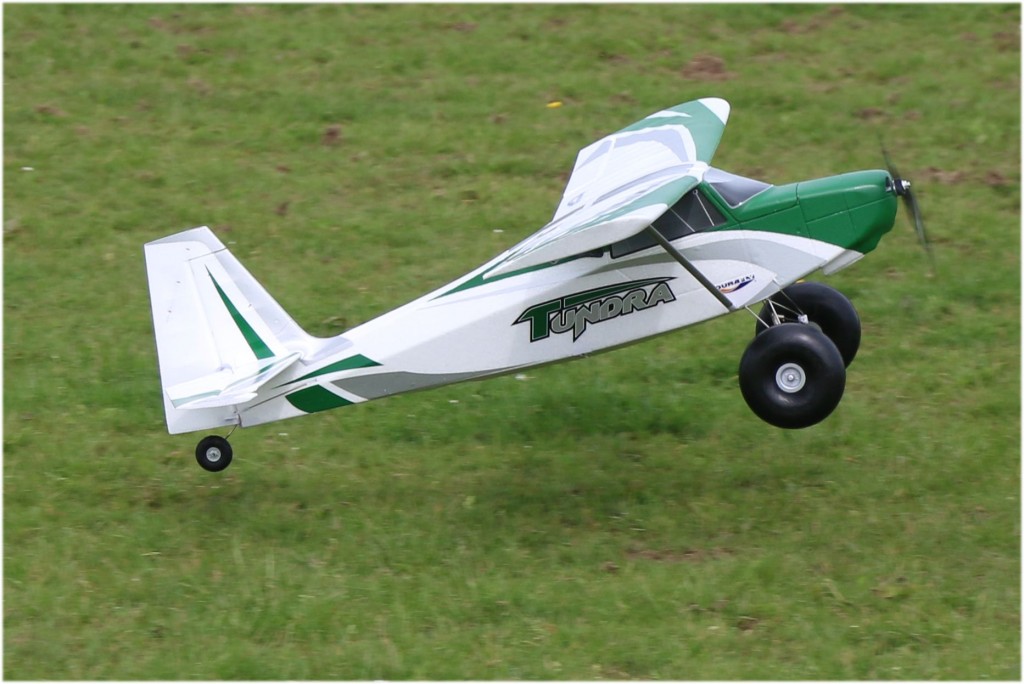


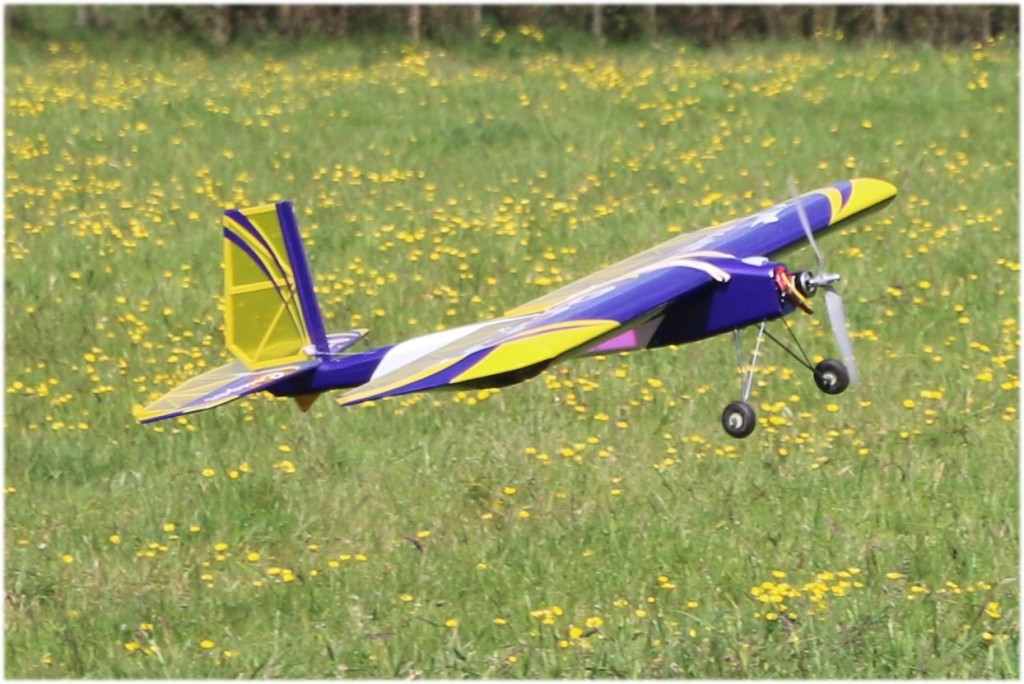
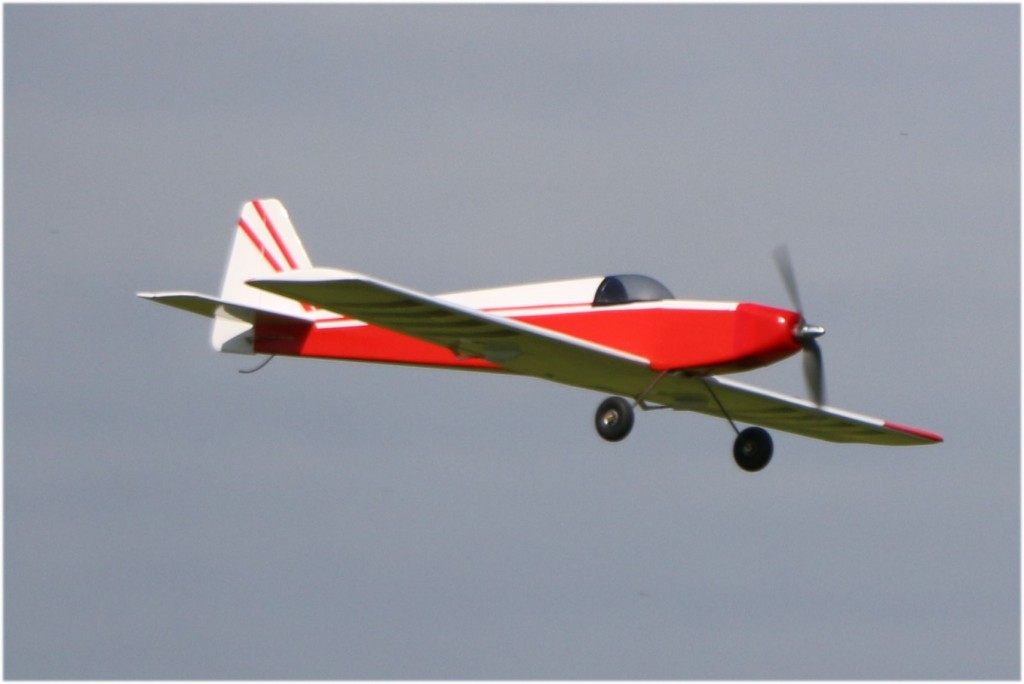
It was great to see the return to flying of Chris P Bacon following his recent triple heart bypass operation. Personally I didn’t realise he had one heart let alone three!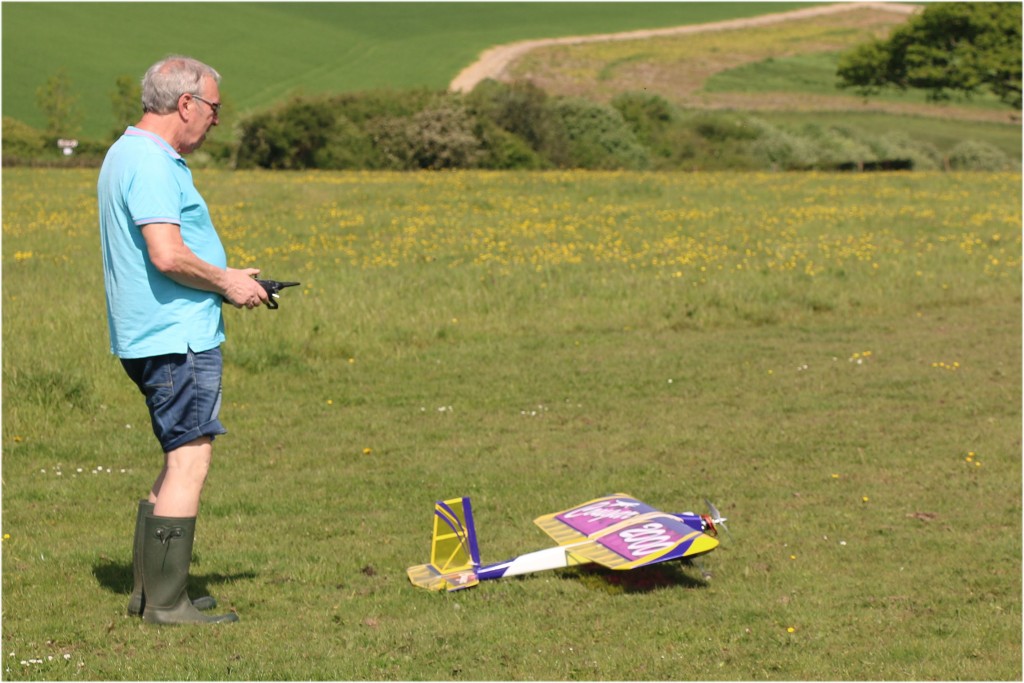 Good to see you back Nigel.
Good to see you back Nigel.
Time for this month’s video:
Please watch the video full screen, it’s so much better with small models flying around. If the video above won’t play for you CLICK HERE
Did you hear about the airline pilot who bragged that when he was born he was offered the choice of either a large manhood or a fantastic memory? Apparently he can’t remember which one he chose…
Colin Cowplain
NO FLYING Sunday 7th May 2017
No flying this Sunday 7th May 2017, as the field will be used as a car park for the South Downs Green Fair at the Sustainability Centre.
There will be no flying for safety reasons.
Patch News – April 2017
After the pretty lousy weather we endured in March things were much better in April, the winds that had been so prevalent in March eased a lot and there was virtually no rain.. Unusually even Easter had good flying weather. Of course nothing is perfect and we had the joy of a herd of bullocks join us in the field for part of the month.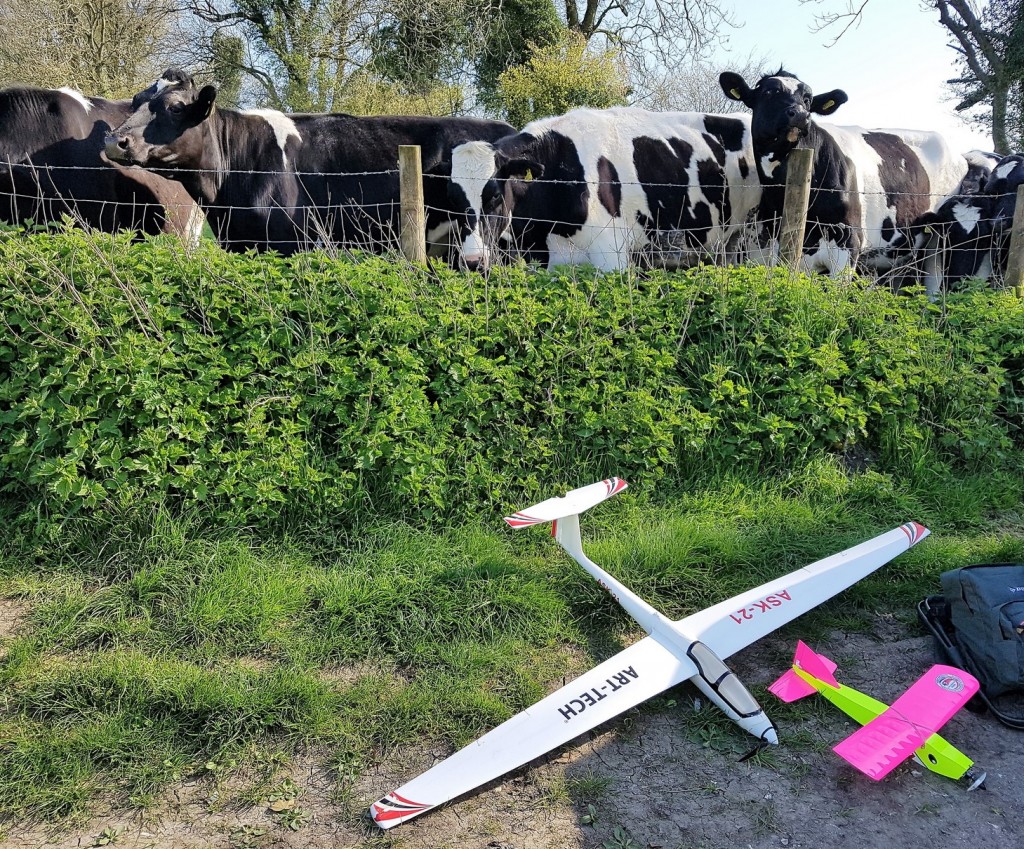 They’ve gone again now although they will obviously return at some point, and I imagine some sheep will also make an appearance before too long. Don’t forget that the South Downs Green Fair is being held at the Sustainability Centre on Sunday 7th May and our field will be used as a car park so there will be no flying that day.
They’ve gone again now although they will obviously return at some point, and I imagine some sheep will also make an appearance before too long. Don’t forget that the South Downs Green Fair is being held at the Sustainability Centre on Sunday 7th May and our field will be used as a car park so there will be no flying that day.
Congratulations are due to Mike Creamer who took and passed his ‘A’ cert on Good Friday.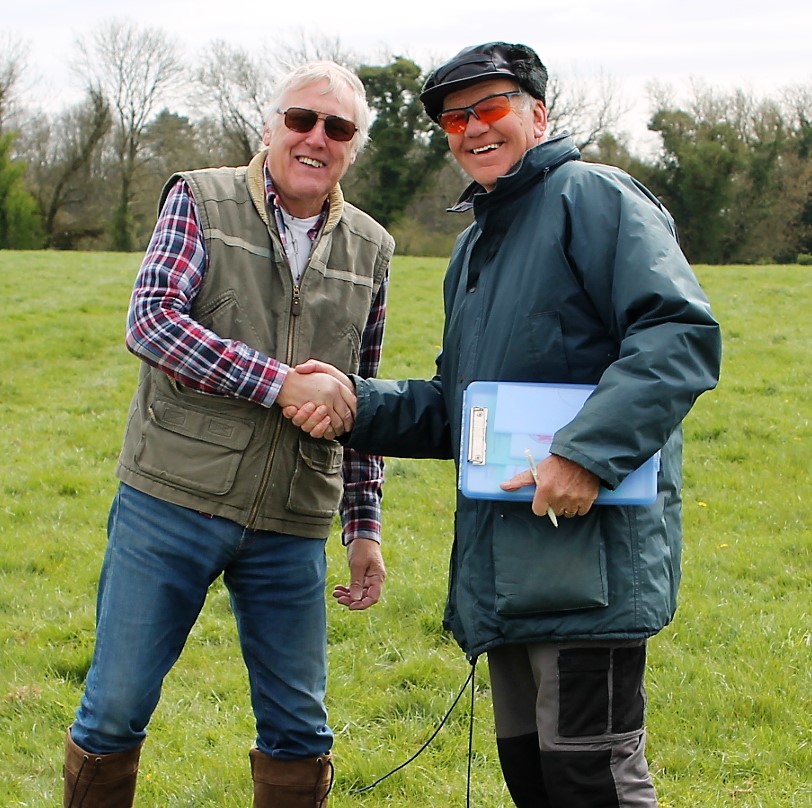 Mike moved up a notch from flying his Pandora trainer to a Wot 4 and it took him a couple of months to get used it, otherwise I’m sure he would have passed earlier. Well done Mike, now you can learn to fly properly! I’m thinking that Mike needs a nickname so, as he passed the test over Easter and seems a good egg, how about Cream Egg? Other suggestions are welcome…
Mike moved up a notch from flying his Pandora trainer to a Wot 4 and it took him a couple of months to get used it, otherwise I’m sure he would have passed earlier. Well done Mike, now you can learn to fly properly! I’m thinking that Mike needs a nickname so, as he passed the test over Easter and seems a good egg, how about Cream Egg? Other suggestions are welcome…
Several new models turned up at the patch in April, and we seem to have slipped into retro mode as both Dougal and I built models the 60’s and 70’s. First up is Dougal’s Ghost Rider 50, a David Boddington design from 1974.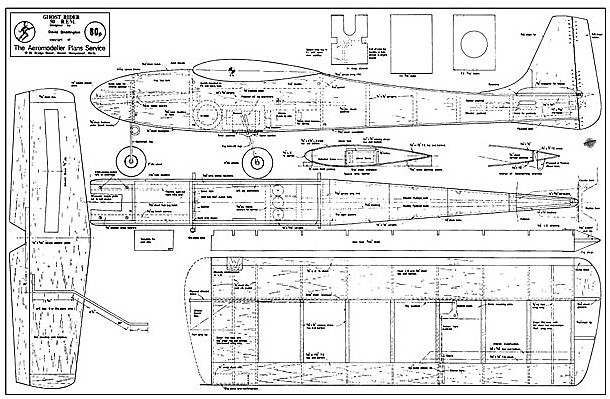 It was originally designed for galloping ghost radio systems and if you don’t know what that was you’d better Google it! This is what Dougal has to say about it: When I first joined Epsom Radio Flying Club in 1977, all the expert fliers seemed to have Ghost Rider 50s. The tricycle undercarriage certainly helped on the rough strip at the Boxhill field. I think the original David Boddington design was for 25-size engines, but the Epsom crowd seemed to favour flat foam wings and 40-size power plants, which made it very neutrally stable (if a bit overpowered). One of my instructors gave me a go on his when I was getting confident with my 3-channel trainer, and I found it a real handful, but it gave me a lot of confidence. I went on to build two of the smaller Ghost Rider 38s for my Enya 19BB, and they were a lot of fun, but I always wanted a ’50, and somehow never got round to it.
It was originally designed for galloping ghost radio systems and if you don’t know what that was you’d better Google it! This is what Dougal has to say about it: When I first joined Epsom Radio Flying Club in 1977, all the expert fliers seemed to have Ghost Rider 50s. The tricycle undercarriage certainly helped on the rough strip at the Boxhill field. I think the original David Boddington design was for 25-size engines, but the Epsom crowd seemed to favour flat foam wings and 40-size power plants, which made it very neutrally stable (if a bit overpowered). One of my instructors gave me a go on his when I was getting confident with my 3-channel trainer, and I found it a real handful, but it gave me a lot of confidence. I went on to build two of the smaller Ghost Rider 38s for my Enya 19BB, and they were a lot of fun, but I always wanted a ’50, and somehow never got round to it.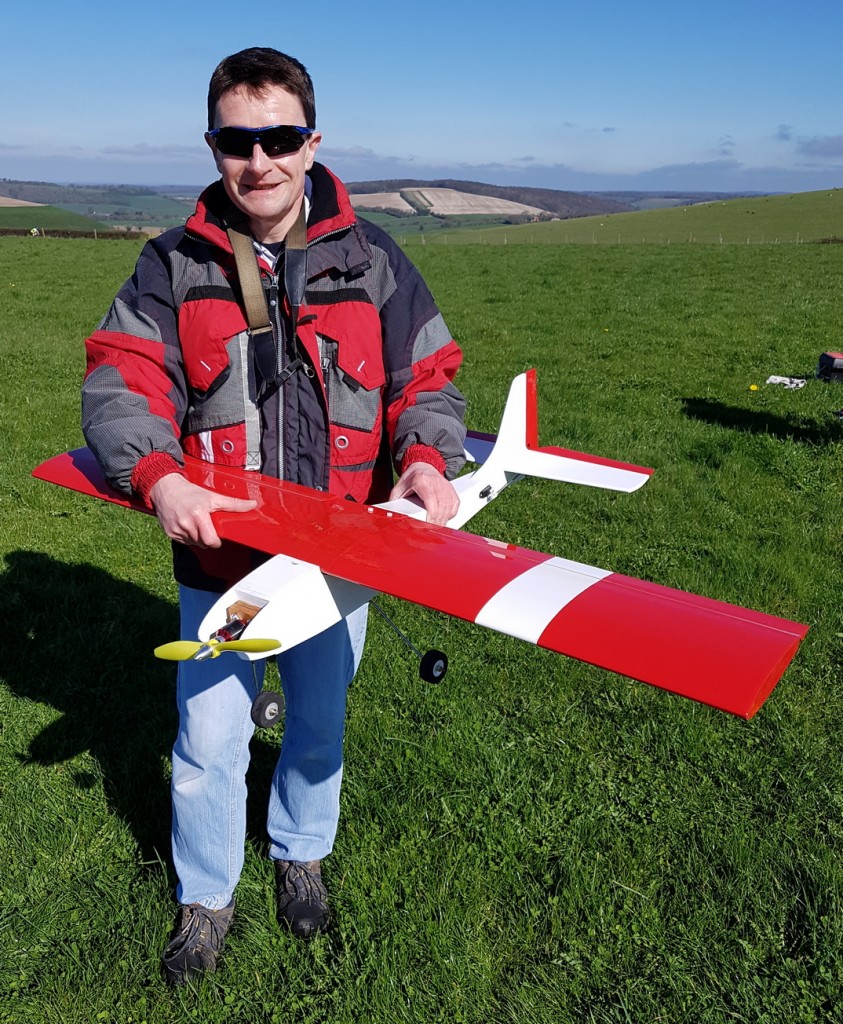 So 40 years on, here I am with one at last. The wings are cut from white foam, with poplar veneer (obechi is getting hard to come by) attached using Gorilla Glue. They seem very strong. I enlarged the fin, rudder and elevator a bit, and also beefed up the fuselage with 1/32″ ply doublers at the front. I knew from my Fun 3 that a 35mm 1000kV motor on a 4s lipo would give similar power to a 40-size IC, so that’s what I used. However, the CopterX motor I found on Ebay seems a bit rough and noisy, so I may replace it with a Turnigy motor identical to the one I used in the Fun 3. It’s got tons of power though, and my 4s 3300mAh packs last about 5 and a half minutes.
So 40 years on, here I am with one at last. The wings are cut from white foam, with poplar veneer (obechi is getting hard to come by) attached using Gorilla Glue. They seem very strong. I enlarged the fin, rudder and elevator a bit, and also beefed up the fuselage with 1/32″ ply doublers at the front. I knew from my Fun 3 that a 35mm 1000kV motor on a 4s lipo would give similar power to a 40-size IC, so that’s what I used. However, the CopterX motor I found on Ebay seems a bit rough and noisy, so I may replace it with a Turnigy motor identical to the one I used in the Fun 3. It’s got tons of power though, and my 4s 3300mAh packs last about 5 and a half minutes.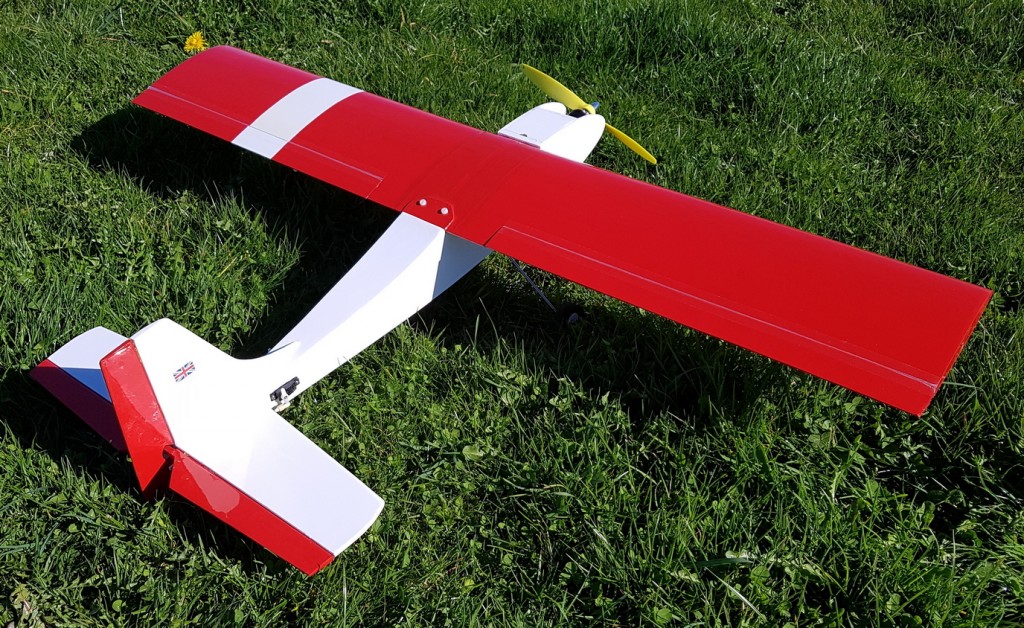
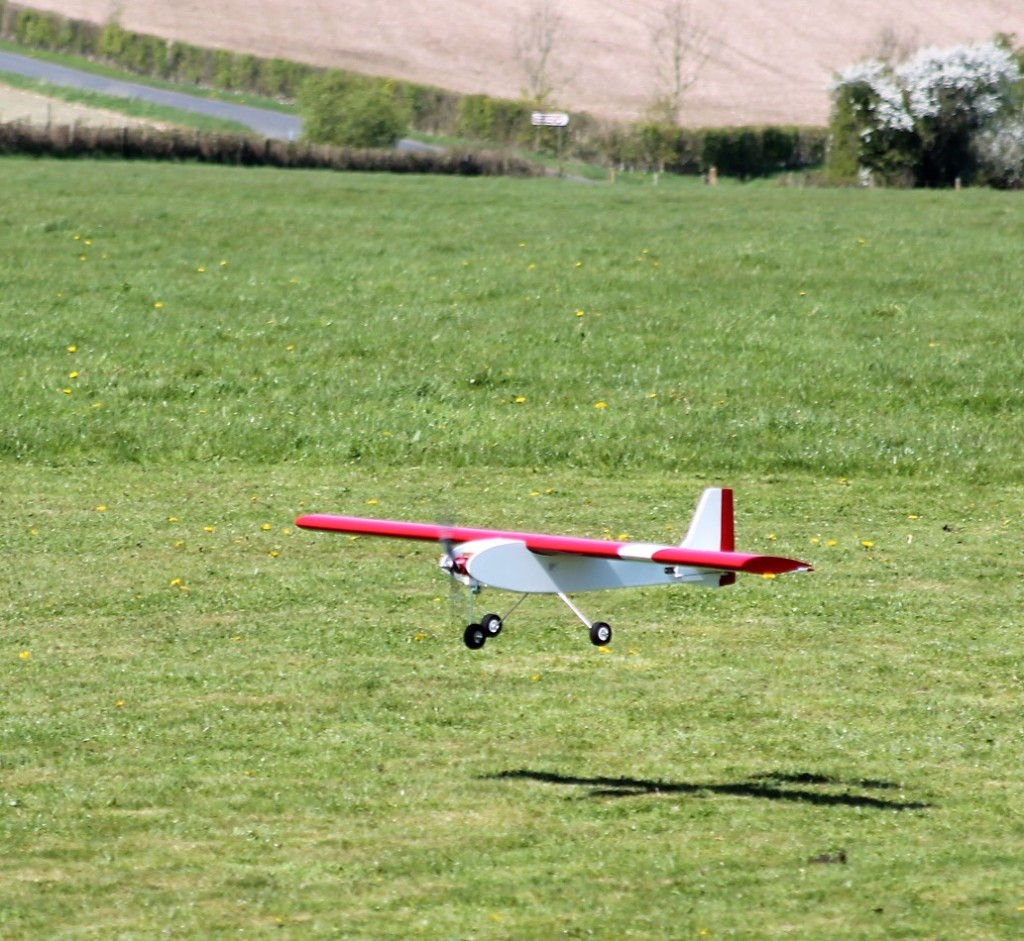 The model flies really well and you can see it in action in this month’s video at the end of this Patch News.
The model flies really well and you can see it in action in this month’s video at the end of this Patch News.
The other retro model first flown in April was my Sharkface that I pictured part built in last month’s edition.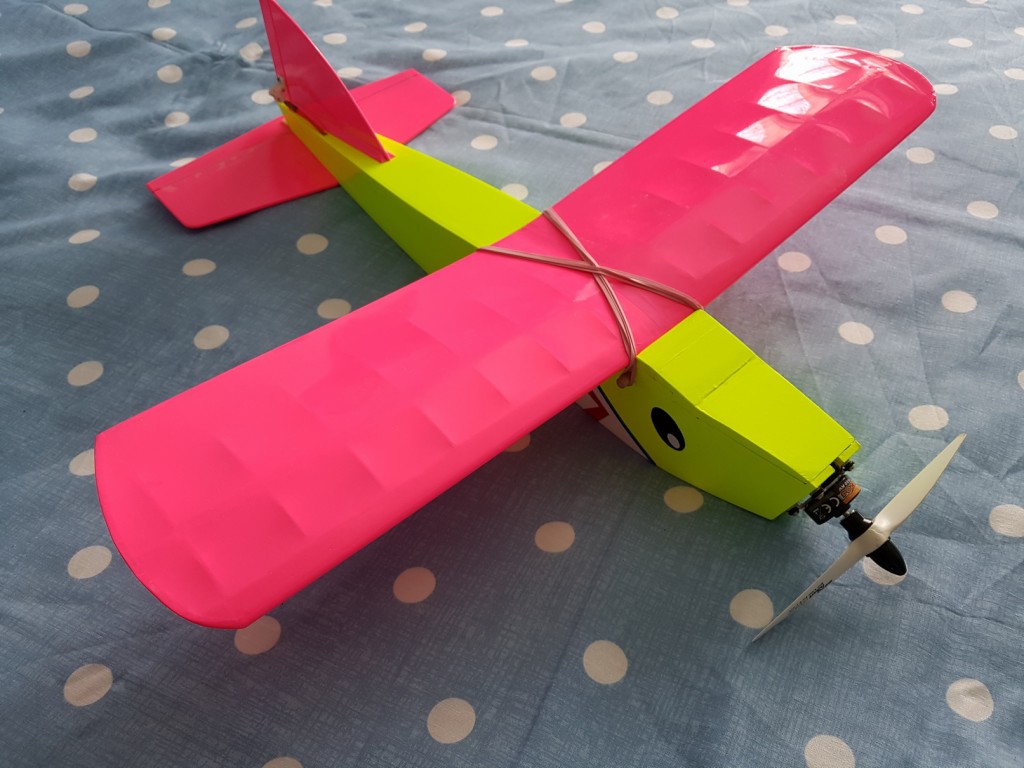
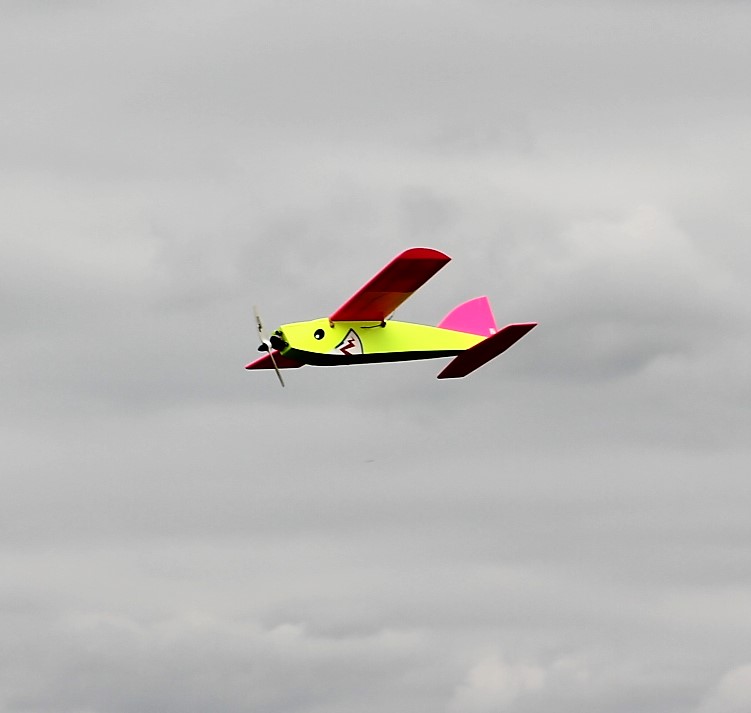 The original was a single channel (rudder only) model designed in 1965 by Eric Clutton and in those days many people fitted them with Cox .049 glow-plug engines, although the design says for up to 1.5cc so some modellers fitted one of the small diesel engines that were popular in the sixties. In March this year RCM&E re-issued the original plan along with an article by Shaun Garrity and also added a Mk2 version of the plan which updated it for modern radio by adding an elevator. To be honest I couldn’t spot any real differences between the two plans apart from a line indicating the elevator hinge point, the plan still shows an I/C engine even though the accompanying article features electric powered models. Mine is electric powered of course and I simply copied Shaun’s choice of motor and used a HobbyKing Donkey ST2004-1550Kv which costs less than a fiver and is suitable for 2 or 3 cells.
The original was a single channel (rudder only) model designed in 1965 by Eric Clutton and in those days many people fitted them with Cox .049 glow-plug engines, although the design says for up to 1.5cc so some modellers fitted one of the small diesel engines that were popular in the sixties. In March this year RCM&E re-issued the original plan along with an article by Shaun Garrity and also added a Mk2 version of the plan which updated it for modern radio by adding an elevator. To be honest I couldn’t spot any real differences between the two plans apart from a line indicating the elevator hinge point, the plan still shows an I/C engine even though the accompanying article features electric powered models. Mine is electric powered of course and I simply copied Shaun’s choice of motor and used a HobbyKing Donkey ST2004-1550Kv which costs less than a fiver and is suitable for 2 or 3 cells. I gather many people are flying their Sharkfaces on small 2 cell packs but I have lots of 3 cell 1000mAh lipos so I’m using those. I added a hatch to save having to remove the wings when swapping batteries, something that is shown in the article but not on the plan, but otherwise it’s built pretty much to the plan. I didn’t bother trying to save weight at all and it came out at 11.3 ounces (320 grams) including the lipo. The article mentions 9 ounces for modern ones and I would imagine mine would be around that if I used a smaller 2 cell lipo. The original single channel ones weighed around 15 ounces, the radio was bigger and heavier in the sixties despite only having one channel! To be properly retro it should be tissue and dope covered of course but I used Solarfilm instead. As the model is only 22” span, and pretty nippy with it, it makes sense to use bright colours so when I rummaged through my box of film and found some very garish pink and bright yellow that seemed ideal. There have been comments about it being a little bit gay; I have no idea how anyone could have got that idea!
I gather many people are flying their Sharkfaces on small 2 cell packs but I have lots of 3 cell 1000mAh lipos so I’m using those. I added a hatch to save having to remove the wings when swapping batteries, something that is shown in the article but not on the plan, but otherwise it’s built pretty much to the plan. I didn’t bother trying to save weight at all and it came out at 11.3 ounces (320 grams) including the lipo. The article mentions 9 ounces for modern ones and I would imagine mine would be around that if I used a smaller 2 cell lipo. The original single channel ones weighed around 15 ounces, the radio was bigger and heavier in the sixties despite only having one channel! To be properly retro it should be tissue and dope covered of course but I used Solarfilm instead. As the model is only 22” span, and pretty nippy with it, it makes sense to use bright colours so when I rummaged through my box of film and found some very garish pink and bright yellow that seemed ideal. There have been comments about it being a little bit gay; I have no idea how anyone could have got that idea!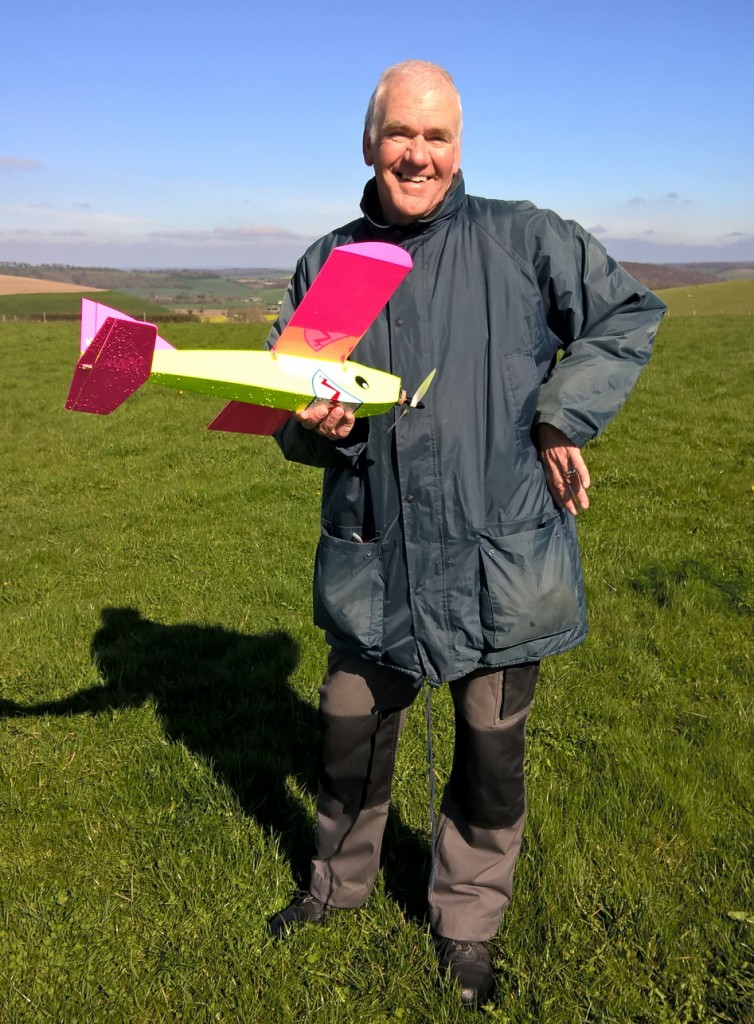 It’s very quick and simple to build, mine only took a week to complete and it flies extremely well. I don’t think anyone could tell it doesn’t have ailerons from the flying performance, it rolls pretty quickly on rudder alone although I must admit I struggle to fly it inverted as it constantly tries to roll itself back upright. I’m far too tight to buy the magazine so Basher Bob lent me the article and plan. On the day I returned it Dwayne Pipe promptly borrowed it again so I think there will soon be at least one more Sharkface in the club. I know I won’t get away without mentioning a small epilogue to the tale. I first flew mine on 2nd April and have already had many flights with it, but later in the month I got disorientated and performed a slightly heavy landing. OK, I admit it, I crashed!
It’s very quick and simple to build, mine only took a week to complete and it flies extremely well. I don’t think anyone could tell it doesn’t have ailerons from the flying performance, it rolls pretty quickly on rudder alone although I must admit I struggle to fly it inverted as it constantly tries to roll itself back upright. I’m far too tight to buy the magazine so Basher Bob lent me the article and plan. On the day I returned it Dwayne Pipe promptly borrowed it again so I think there will soon be at least one more Sharkface in the club. I know I won’t get away without mentioning a small epilogue to the tale. I first flew mine on 2nd April and have already had many flights with it, but later in the month I got disorientated and performed a slightly heavy landing. OK, I admit it, I crashed!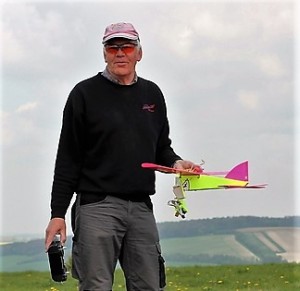
 Fortunately the damage was easily repaired and I flew it again the following day but it does highlight the importance of making them brightly covered and keeping fairly close in when flying.
Fortunately the damage was easily repaired and I flew it again the following day but it does highlight the importance of making them brightly covered and keeping fairly close in when flying.
While I’m on the subject of retro models, I recently stumbled across a photo of ten PAM members holding their Top Dawg models. In the photo, from left to right, back row: Reg Street, Ian Hewlett, Viv Burgess, Ken Boucher, and Don Hoolahan. Front row: Dave Rice, Mike Upton, Don Eades, Andy Palmer, and Harold Bolwell.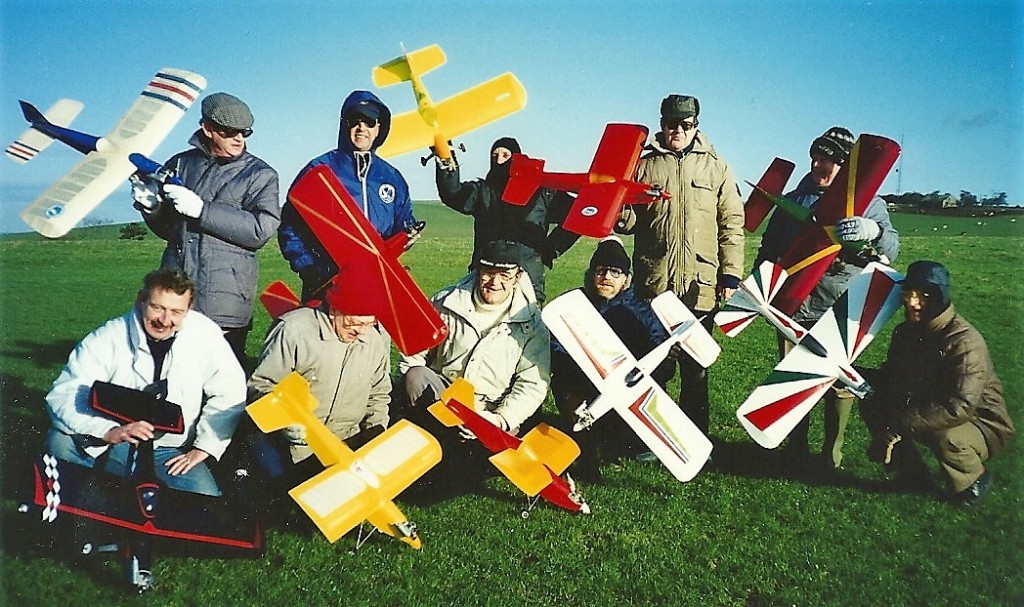 The Top Dawg was a 36” span Ken Willard design from 1966 and it was in the period when radio sets were changing quickly so it was capable of being flown with either single channel radio, galloping ghost, or multi-channel reed sets.
The Top Dawg was a 36” span Ken Willard design from 1966 and it was in the period when radio sets were changing quickly so it was capable of being flown with either single channel radio, galloping ghost, or multi-channel reed sets.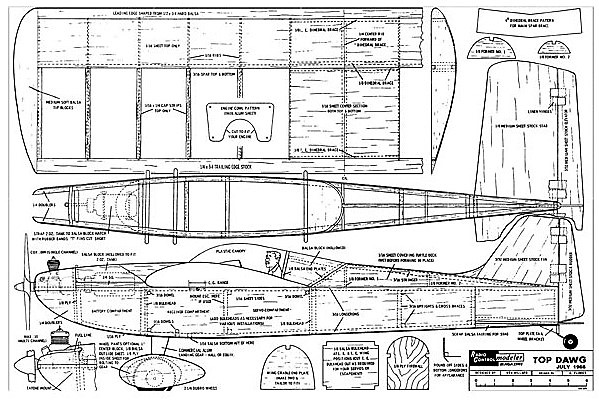 It was intended for engines ranging from the little Cox .049 (0.8cc) up to .15cu in. (2.5cc) and PAM chose it for their Club Build model one year using .15 engines. If I remember correctly about fifteen were built, all three channel, rudder, elevator, and throttle, no ailerons, and they all flew well. Like the Sharkface they all rolled well and didn’t suffer from the lack of ailerons. Most were fitted with the cheap and ever reliable OS15 but a couple, including President Don’s, used a Taipan 15 rear exhaust engine that was more powerful although proved to be less reliable. Oddly, despite their Japanese sounding name Taipans were actually designed and manufactured in Australia.
It was intended for engines ranging from the little Cox .049 (0.8cc) up to .15cu in. (2.5cc) and PAM chose it for their Club Build model one year using .15 engines. If I remember correctly about fifteen were built, all three channel, rudder, elevator, and throttle, no ailerons, and they all flew well. Like the Sharkface they all rolled well and didn’t suffer from the lack of ailerons. Most were fitted with the cheap and ever reliable OS15 but a couple, including President Don’s, used a Taipan 15 rear exhaust engine that was more powerful although proved to be less reliable. Oddly, despite their Japanese sounding name Taipans were actually designed and manufactured in Australia. My Top Dawg was the last I/C powered model that I built, before building my first electric model in August 1991 so I would imagine the group photo was taken in 1990. Oddly enough my Top Dawg was the only plane I’ve had catch fire! I was starting the engine one day when it backfired and ignited some unburnt fuel in the silencer that promptly set fire to the film covering on the wing. Fortunately I was able to immediately throw a damp cloth onto the wing and the only damage was a small burnt patch of the wing covering. That’s not the best photo I’ve ever seen of me!
My Top Dawg was the last I/C powered model that I built, before building my first electric model in August 1991 so I would imagine the group photo was taken in 1990. Oddly enough my Top Dawg was the only plane I’ve had catch fire! I was starting the engine one day when it backfired and ignited some unburnt fuel in the silencer that promptly set fire to the film covering on the wing. Fortunately I was able to immediately throw a damp cloth onto the wing and the only damage was a small burnt patch of the wing covering. That’s not the best photo I’ve ever seen of me!
Basher Bob has been at it again. No, this time I mean balsa bashing, although there wouldn’t have been much of it to complete his latest model, a balsa built Wot 4-E Mk2 ARTF. This one is slightly smaller than original size Wot 4 at 47” span. Ripmax say it’s 80% scale but that would mean the original was 58.75” span, I thought it was 53”. Not sure, anyway this one is designed specifically for electric power using 3 cell batteries of around 2200mAh capacity.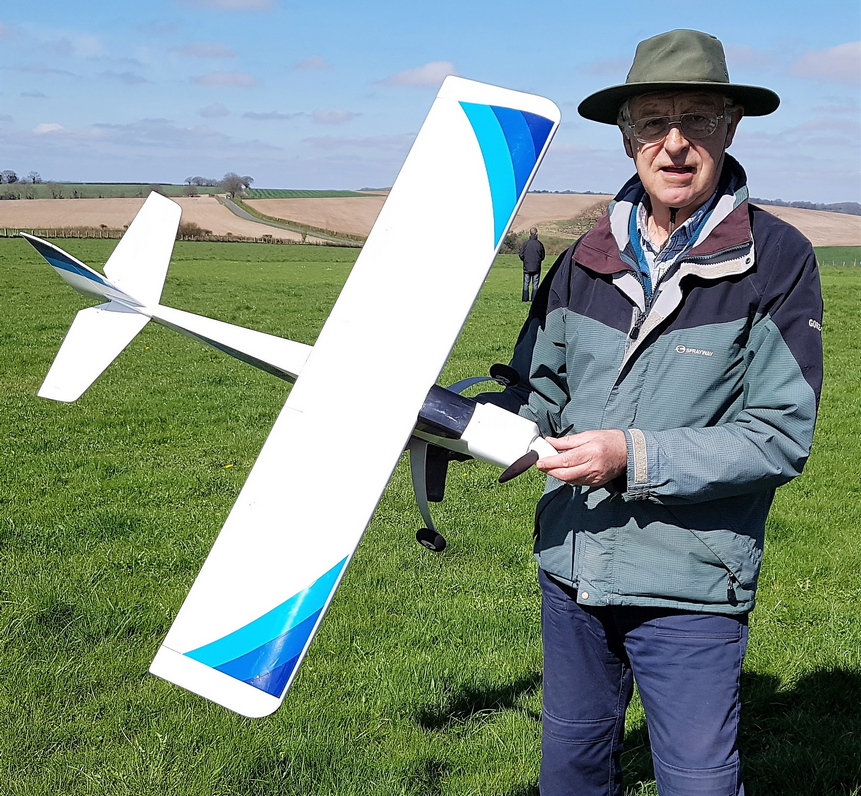
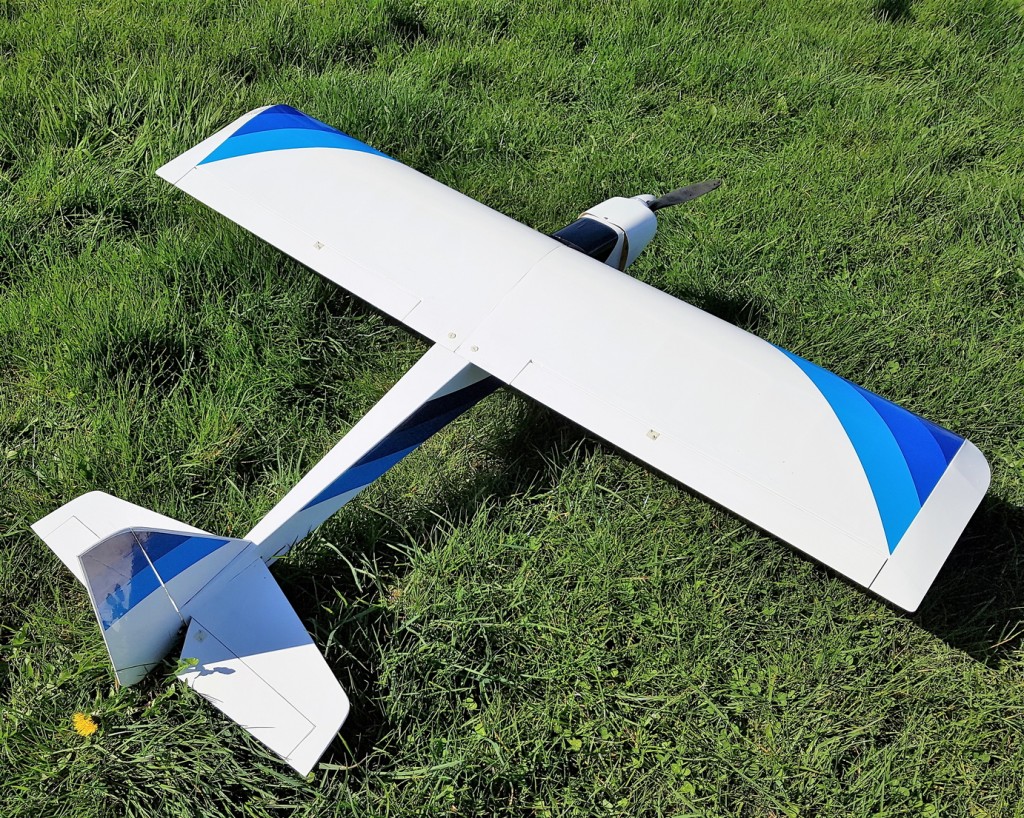 It uses a lighter wooden construction method than the larger one, a fibreglass cowl, an aluminium undercarriage and, being specifically for electric power, an easy access battery hatch. I’m not sure what motor Bob originally fitted but it didn’t sound very well so he’s now swapped it to an ex-Calmato motor and that seems much better. It pulls about 400 watts on 3 cells but, Basher being Basher, he sometimes uses 4 cells for a bit more fun!
It uses a lighter wooden construction method than the larger one, a fibreglass cowl, an aluminium undercarriage and, being specifically for electric power, an easy access battery hatch. I’m not sure what motor Bob originally fitted but it didn’t sound very well so he’s now swapped it to an ex-Calmato motor and that seems much better. It pulls about 400 watts on 3 cells but, Basher being Basher, he sometimes uses 4 cells for a bit more fun! It goes very well, in fact it flies just as well as all the Wot 4s fly. I’d love to know how many Wot 4s have been made since Chris Foss designed the original in 1977, there are now more versions available than ever before so my guess would be in the tens of thousands. Hang on, 1977, does that mean Basher’s Wot 4 is yet another retro model?!
It goes very well, in fact it flies just as well as all the Wot 4s fly. I’d love to know how many Wot 4s have been made since Chris Foss designed the original in 1977, there are now more versions available than ever before so my guess would be in the tens of thousands. Hang on, 1977, does that mean Basher’s Wot 4 is yet another retro model?!
The next new one is definitely not a retro model, it’s Catapult King’s new FT-3D or as he calls it The Bug. The FT part of the name is Flite Test which is an American web-based company that produces a large range of models, either plans or kit form, mostly made of Depron or foam board. The website has lots of videos, articles on equipment etc, and as well as the models they also sell lots of the electronic parts we use, in fact almost everything you are likely to need to build a model. It’s well worth a look at their website: Flite Test
Back to the model; it’s virtually all Depron construction, with just a balsa spar to provide some strength to the wing.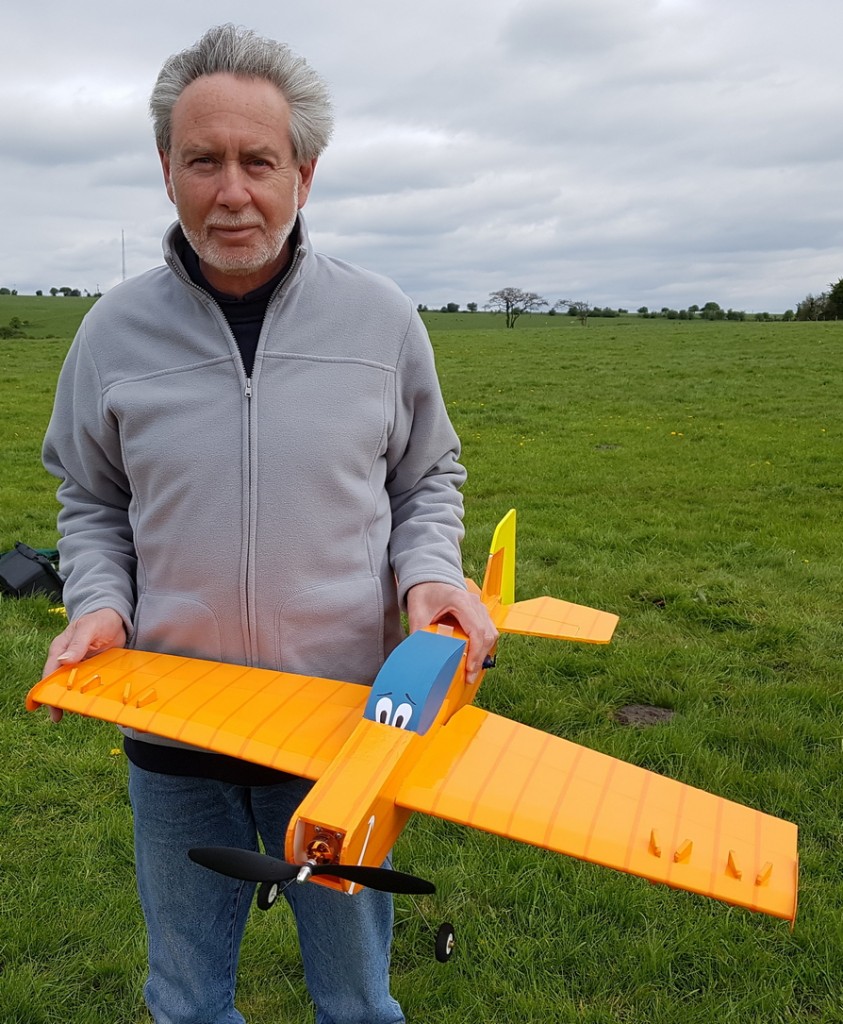 The motor is a Turnigy 2830-1000Kv, and Catapult drives it with a 3 cell 1300mAh Zippy battery and it spins a 10×4.7 prop. So that’s basically the same set-up as many of us use in our Hummers. The symmetrical wing is made using one piece of Depron that is folded over to form the leading edge and only glued at the spar position (there is no leading edge as such). Catapult added the packing tape covering before folding the Depron back on itself to prevent it from snapping. The whole model is covered in the same tape and the overlaps produce the stripes that look so good. I don’t imagine it was very easy to get the stripe pattern nice and even like that.
The motor is a Turnigy 2830-1000Kv, and Catapult drives it with a 3 cell 1300mAh Zippy battery and it spins a 10×4.7 prop. So that’s basically the same set-up as many of us use in our Hummers. The symmetrical wing is made using one piece of Depron that is folded over to form the leading edge and only glued at the spar position (there is no leading edge as such). Catapult added the packing tape covering before folding the Depron back on itself to prevent it from snapping. The whole model is covered in the same tape and the overlaps produce the stripes that look so good. I don’t imagine it was very easy to get the stripe pattern nice and even like that.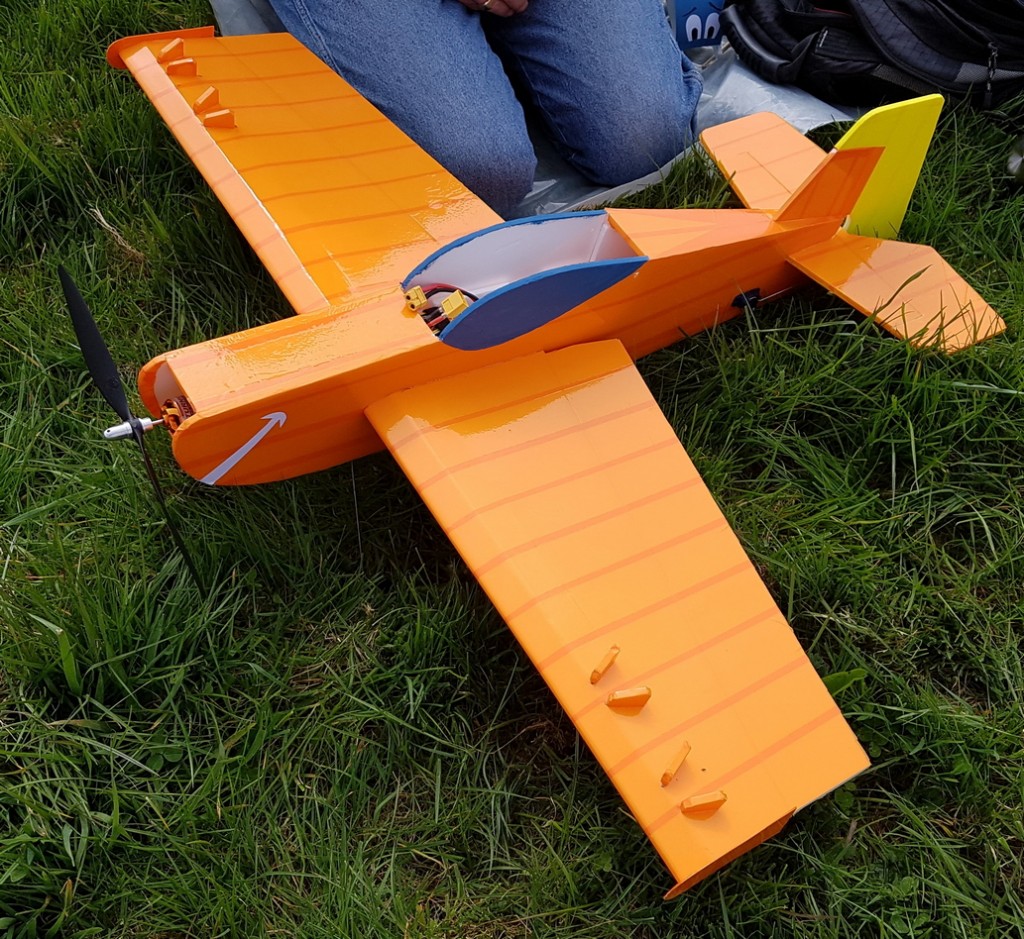
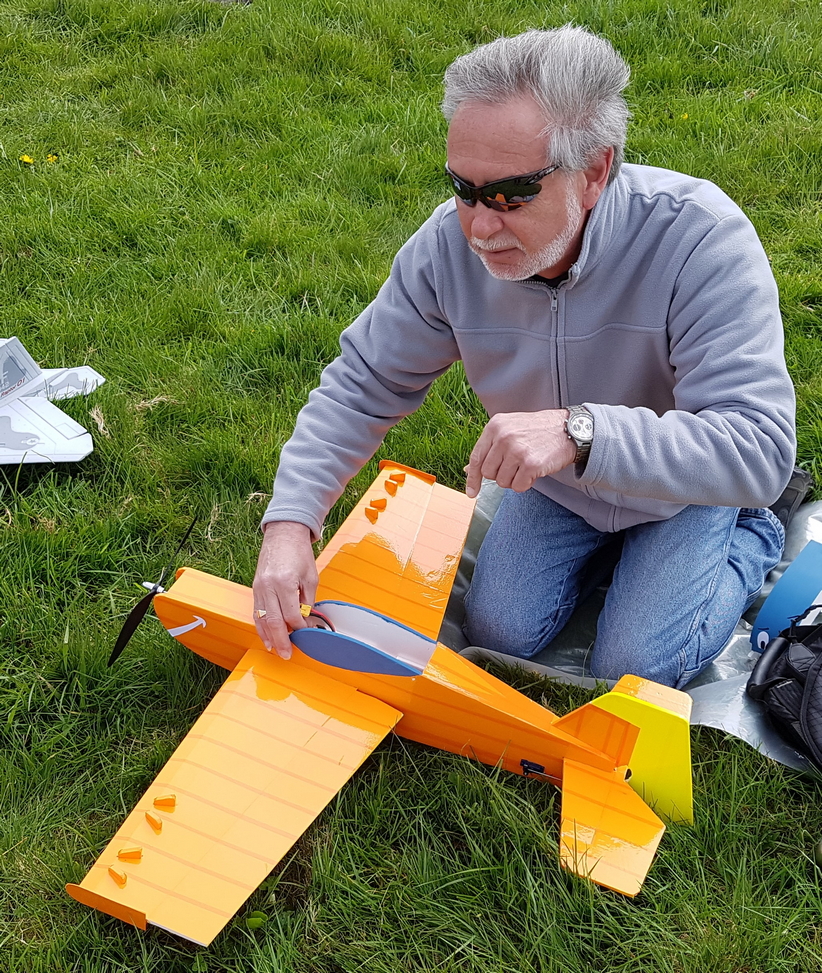 The Bug is also unusual in that it uses a Flite Test Power Pod, a Depron structure that holds the motor, battery, and speed controller, which can slide out of the model and then slide straight into a different model. Look at the website, it will make more sense! Catapult decided it needed a bit more character so he added the eyes and mouth and transformed it into The Bug. I like it, it looks like something out of a Disney cartoon! 1066 did the initial flight tests and I’ve also flown it. The finished model is very light and needs fairly calm conditions but seems good so far. It is supposed to be capable of all the basic 3D manoeuvres so we shall soon be seeing great things from Catapult.
The Bug is also unusual in that it uses a Flite Test Power Pod, a Depron structure that holds the motor, battery, and speed controller, which can slide out of the model and then slide straight into a different model. Look at the website, it will make more sense! Catapult decided it needed a bit more character so he added the eyes and mouth and transformed it into The Bug. I like it, it looks like something out of a Disney cartoon! 1066 did the initial flight tests and I’ve also flown it. The finished model is very light and needs fairly calm conditions but seems good so far. It is supposed to be capable of all the basic 3D manoeuvres so we shall soon be seeing great things from Catapult.
The last new model that I captured was The Squire’s new Wingnetic, the prize he won in the last big raffle. Not much to say about the Wingnetic, except they are a flying wing development of the Kinetic mini glider and, like the Kinetic, they fly extremely well. There are several in the club, including my own, and they are great to just chuck in the car and fly. In this month’s video you’ll see that 1066 did the initial trimming and The Squire happily flew it from then onwards. Would you like one? Well like so many other things the prices are going up but right now the Plug’n’Fly version is cheaper from Rapid RC Models than from HobbyKing.
Not much to say about the Wingnetic, except they are a flying wing development of the Kinetic mini glider and, like the Kinetic, they fly extremely well. There are several in the club, including my own, and they are great to just chuck in the car and fly. In this month’s video you’ll see that 1066 did the initial trimming and The Squire happily flew it from then onwards. Would you like one? Well like so many other things the prices are going up but right now the Plug’n’Fly version is cheaper from Rapid RC Models than from HobbyKing.
The highlight of April occurred when Gentleman Jim turned up at the patch with a combined rucksack and seat. It’s actually called a Dunlop Fishing Stool and Rucksack but it suits our purposes as well as fishermen and costs just £19.99 from Argos. I liked it immediately and bought one for myself, then a few days later Basher Bob joined in. Since the photo was taken Woody has also succumbed, and then there were four! I see that online there are similar versions available from other manufacturers, so if you’d like to join the Stool Club search online and take your pick.
Since the photo was taken Woody has also succumbed, and then there were four! I see that online there are similar versions available from other manufacturers, so if you’d like to join the Stool Club search online and take your pick.
Catapult was good enough to send me several photos that he took during April, here’s a selection for you to enjoy: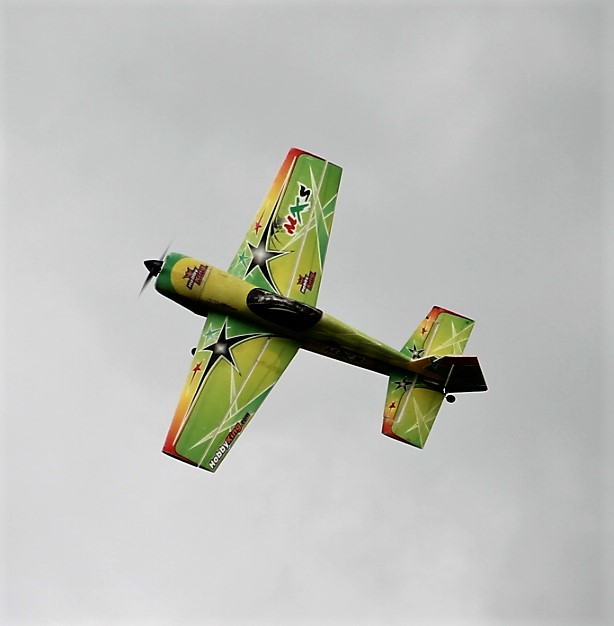
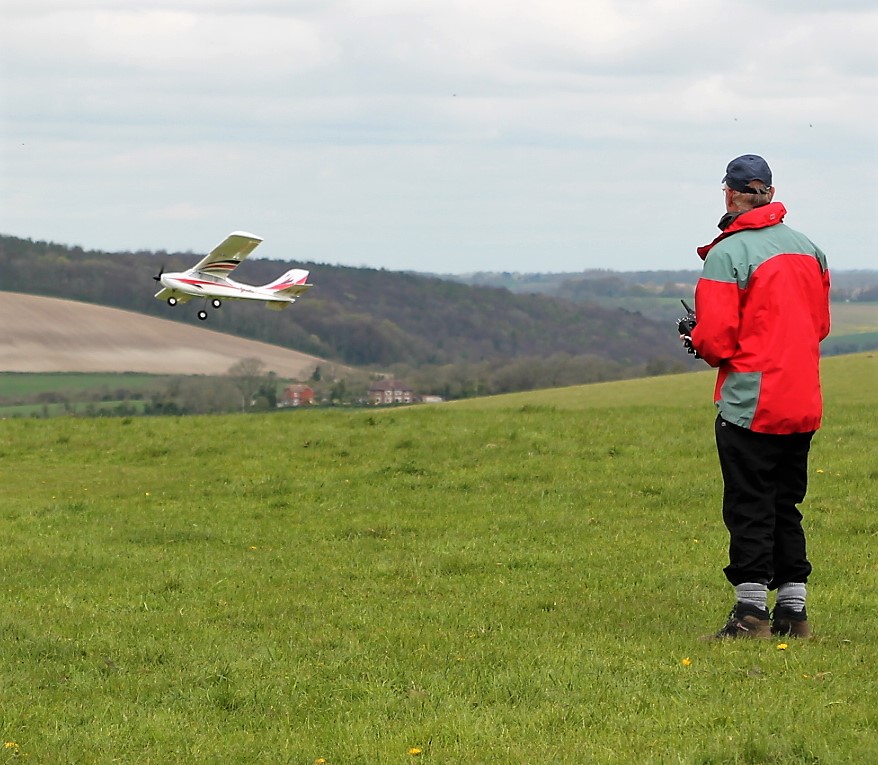
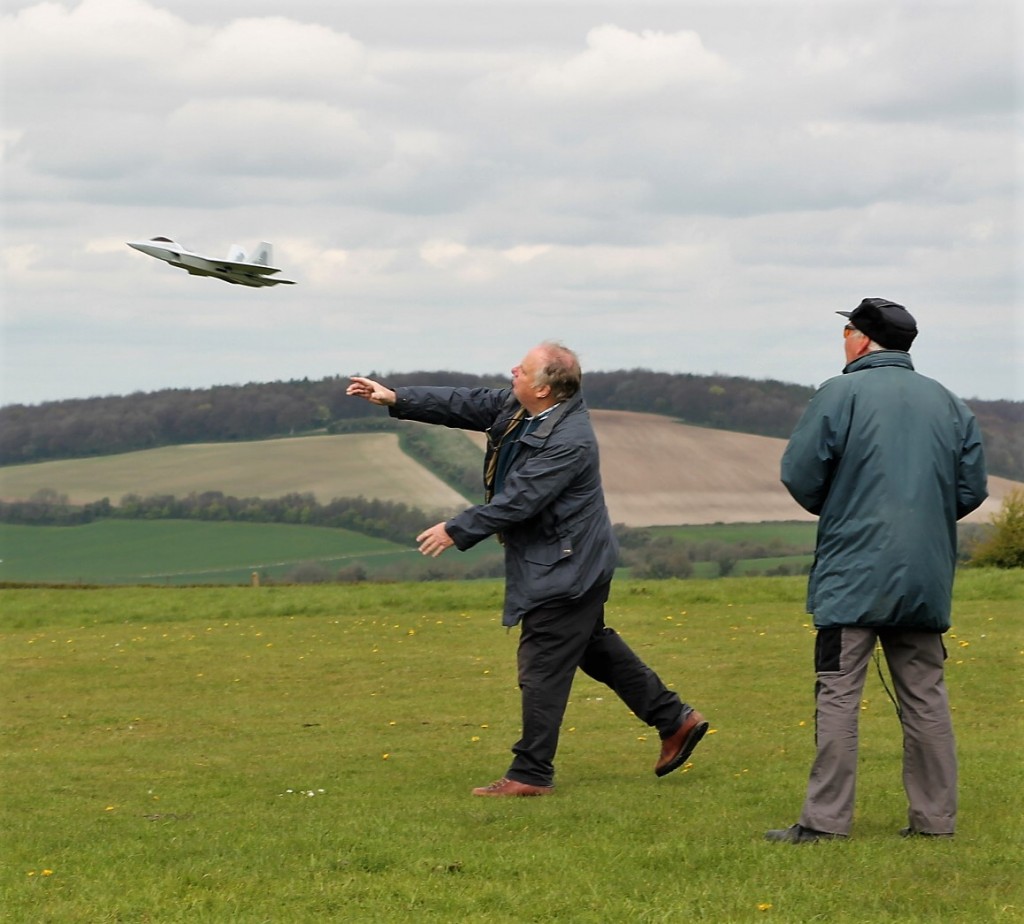
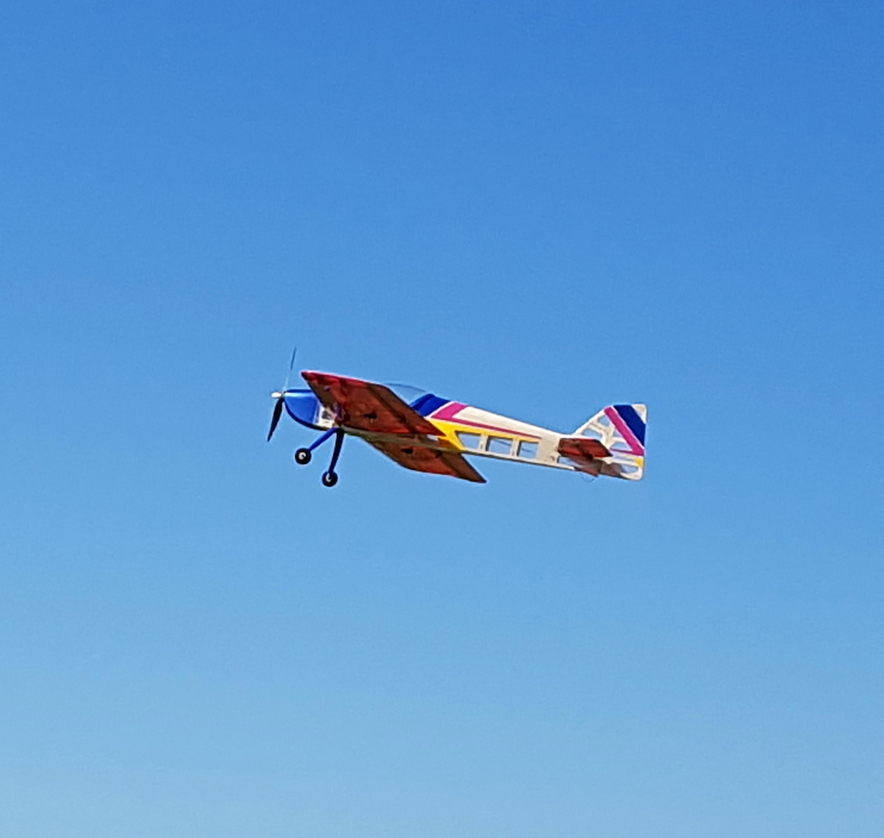
OK, time for this month’s video:Please watch the video full screen, it’s so much better with small models flying around. If the video above won’t play for you CLICK HERE
This month’s joke was provided by Dougal so any complaints should be directed to him please. If you don’t understand it either watch Top Gun or ask Woody:
“I got kicked out of karaoke night for singing “Danger Zone” six times in a row…
They said I exceeded my maximum number of Loggins attempts.”
Colin Cowplain
Patch News – March 2017
Well March certainly lived up to the old rhyme “March winds and April showers…” Let’s hope the April showers aren’t as prolific as the March winds have been. We still managed to get some flying in although on the really windy days it was left to the more experienced fliers. As usual the Sundays seemed to get the worst of the weather.
Whatever happened to the ‘good old days’ when we would fly in virtually any conditions? I found this old photo of one such idiot, no idea who it is but he’s flying a Splot with what looks like an OS 4-stroke. I’m not sure if he’s wrapped up against the elements or if he’s expecting a chemical warfare attack!
I’m not sure if he’s wrapped up against the elements or if he’s expecting a chemical warfare attack!
We heard a couple of bits of sad news during March; firstly that Mick Preedy had passed away on the 19th February. Mick was a long term modeller and had been a PAM member for quite a few years. I first met him back in the sixties when he was flying control-line stunt models along with our President Don Eades. In those days he lived in Madeline Road in Petersfield and later he moved to West Meon where he lived for the rest of his life. Mick is probably best described as a ‘character’; he could turn his hand to anything and was always willing to help anyone who needed it. Several current and ex-members of PAM attended his funeral on 9th March, which, although it sounds a bit odd, was the most enjoyable funeral I’ve attended. I’ve certainly never been to one where the processional music was by Jimi Hendrix, excellent!
The other piece of sad news we heard was the death of Ralph Hubbard who died a week after crashing a toboggan on the Cresta Run in Switzerland on 15th February. Ralph was the pilot who used to fly over our patch in either his Tiger Moth or Yak and would often treat us to aerobatic displays. He even landed the Tiger in the field a couple of times and came to say hello. I spoke to him of the last occasion and he said he’d tried flying radio control models but it was too difficult so he stuck to full-size!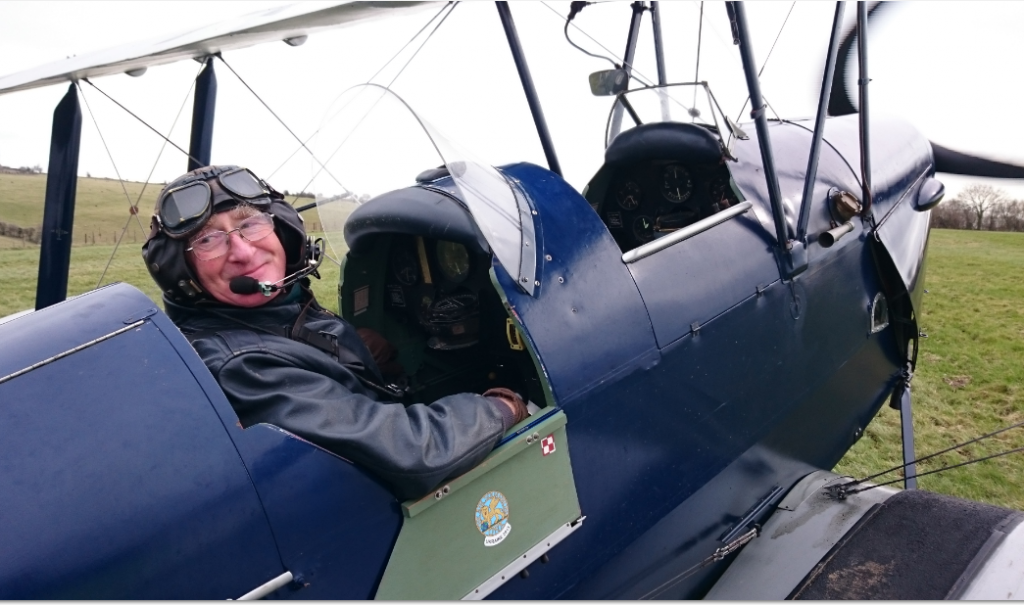 When Basher Bob built a Tiger Moth last year he finished it in the colours of Ralph’s Tiger G-APMX, so his memory will still be flown at the field. Although none of us could say we knew Ralph we all appreciated his impromptu displays and he will be missed.
When Basher Bob built a Tiger Moth last year he finished it in the colours of Ralph’s Tiger G-APMX, so his memory will still be flown at the field. Although none of us could say we knew Ralph we all appreciated his impromptu displays and he will be missed.
March didn’t see much in the way of new models, one of only two I spotted was Gentleman Jim’s Red Eagle electric glider. The Red Eagle was designed by Ton van Munsteren and featured as an RCM&E article along with a free plan. My photo editor has an ‘enhance’ button to improve the quality of photos. Sometimes it produces odd effects, this is what happened when I enhanced the one above!
My photo editor has an ‘enhance’ button to improve the quality of photos. Sometimes it produces odd effects, this is what happened when I enhanced the one above!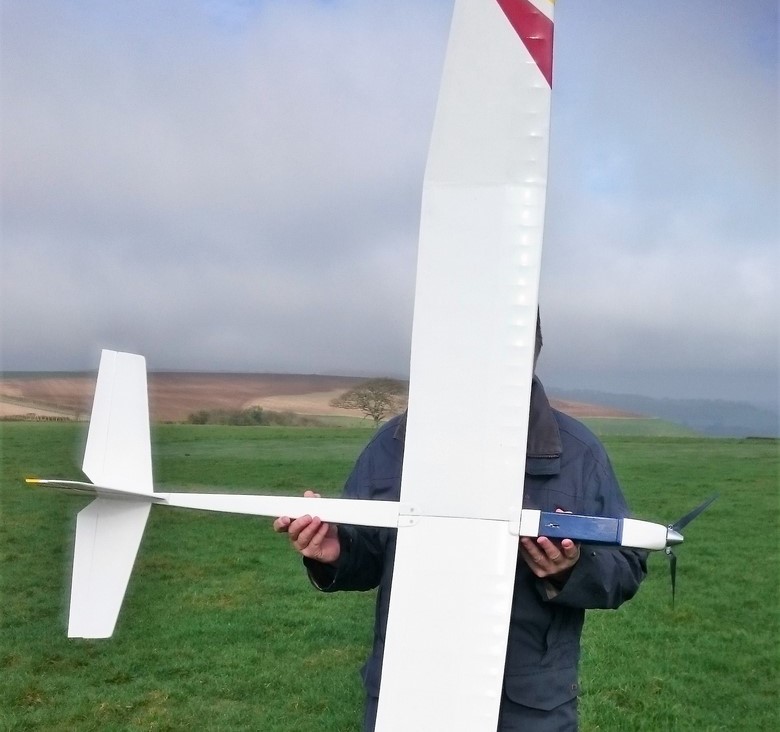 RBC Kits in the Netherlands produce a laser cut kit of the model and that’s the route that Jim took. It’s a 2 metre span 3 channel model, so it doesn’t have ailerons, just rudder, elevator, and throttle controls. There has been quite a lot of magazine coverage and forum features of the Red Eagle and there have also been some comps specifically for them so it’s a well rated design. Jim has made a lovely job of his Red Eagle and has fitted it out with a 28-30 1000kV motor with a 10 x 6 prop, a 30A esc, and a 2200mAh 3 cell lipo pack.
RBC Kits in the Netherlands produce a laser cut kit of the model and that’s the route that Jim took. It’s a 2 metre span 3 channel model, so it doesn’t have ailerons, just rudder, elevator, and throttle controls. There has been quite a lot of magazine coverage and forum features of the Red Eagle and there have also been some comps specifically for them so it’s a well rated design. Jim has made a lovely job of his Red Eagle and has fitted it out with a 28-30 1000kV motor with a 10 x 6 prop, a 30A esc, and a 2200mAh 3 cell lipo pack. I was looking forward to the test flight but then spotted that one wing had developed a warp. It was strange as I had examined the model when Jim was assembling it down by the cars and it all looked straight, but having sat in the sunshine for a hour a twist had developed in the right hand wing. We decided to fly it anyway and it duly took to the air. All was well apart from the twisted wing making it a bit difficult to keep straight so having proved the power train etc. was ok we called it a day and Jim went off to do some straightening. He said the trailing edge wood provided in the kit had been very soft and thinks it wasn’t up to the job, so he has now stripped off the covering and stiffened the structure somewhat. Once he’s got it all covered again we’ll have another go and I’m sure it will be a good performer so look for a full report in the next Patch News.
I was looking forward to the test flight but then spotted that one wing had developed a warp. It was strange as I had examined the model when Jim was assembling it down by the cars and it all looked straight, but having sat in the sunshine for a hour a twist had developed in the right hand wing. We decided to fly it anyway and it duly took to the air. All was well apart from the twisted wing making it a bit difficult to keep straight so having proved the power train etc. was ok we called it a day and Jim went off to do some straightening. He said the trailing edge wood provided in the kit had been very soft and thinks it wasn’t up to the job, so he has now stripped off the covering and stiffened the structure somewhat. Once he’s got it all covered again we’ll have another go and I’m sure it will be a good performer so look for a full report in the next Patch News.
The other new model that flew was Basher Bob’s Bitty. The Bitty was a free plan in RCM&E and is billed as ‘perfect for the slope or piggy-back launching’. It’s a tiny two channel glider that in Basher’s case is launched from his Seagull Swift. The original plan shows a conventional built-up balsa wing with a lifting section but Basher has modified it by building a Depron wing with a Kline Fogleman section featuring two steps. It has balsa leading and trailing edges and a carbon spar to provide the strength. Other than the wing the Bitty is as per plan and features rudder and elevator controls with the servos and receiver being powered by a tiny single cell lipo via a voltage booster. Basher has constructed a Depron cradle that is simply rubber banded to the Swift wing and carries the Bitty. The Bitty is held in the cradle by a rubber band that hooks over a servo arm. Once a suitable height is reached, the servo releases the band and the Bitty glides back to earth.
Other than the wing the Bitty is as per plan and features rudder and elevator controls with the servos and receiver being powered by a tiny single cell lipo via a voltage booster. Basher has constructed a Depron cradle that is simply rubber banded to the Swift wing and carries the Bitty. The Bitty is held in the cradle by a rubber band that hooks over a servo arm. Once a suitable height is reached, the servo releases the band and the Bitty glides back to earth.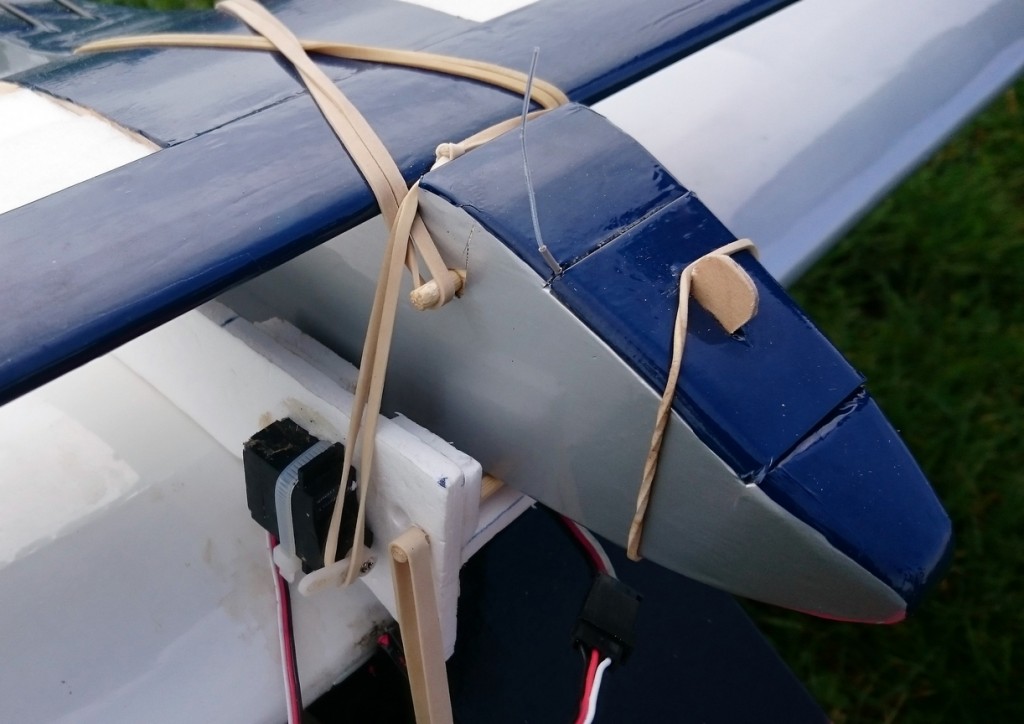 Well that’s the theory anyway, although in practice it hasn’t worked quite that perfectly so far. The main problem seems to be holding the Bitty in place firmly but not too firmly that it won’t release. The Swift flies faster than the Bitty’s flying speed so it tries to lift out of the cradle and tends to tip to one side or the other. On some flights it released itself, presumably the forces pulled the band off the servo prematurely, but every flight was completed safely and neither the Swift nor the Bitty suffered any damage.
Well that’s the theory anyway, although in practice it hasn’t worked quite that perfectly so far. The main problem seems to be holding the Bitty in place firmly but not too firmly that it won’t release. The Swift flies faster than the Bitty’s flying speed so it tries to lift out of the cradle and tends to tip to one side or the other. On some flights it released itself, presumably the forces pulled the band off the servo prematurely, but every flight was completed safely and neither the Swift nor the Bitty suffered any damage. So Basher has gone back to the workshop to make a few changes to the cradle, and hopefully the next time out will be better. The glide angle of the Bitty wasn’t too good so while he’s in the workshop Basher is also building a wing with a lifting section as per plan. You can see the very first flight in this month’s video at the end of Patch News.
So Basher has gone back to the workshop to make a few changes to the cradle, and hopefully the next time out will be better. The glide angle of the Bitty wasn’t too good so while he’s in the workshop Basher is also building a wing with a lifting section as per plan. You can see the very first flight in this month’s video at the end of Patch News.
1066 has invested some of his hard earned cash in a piece of new technology that has just become available. It’s the Hitec HUD System, the HUD standing for Head Up Display. It uses the telemetry capability of the transmitter but instead of having to glance down at the tx screen the information is projected onto the inside of the goggles.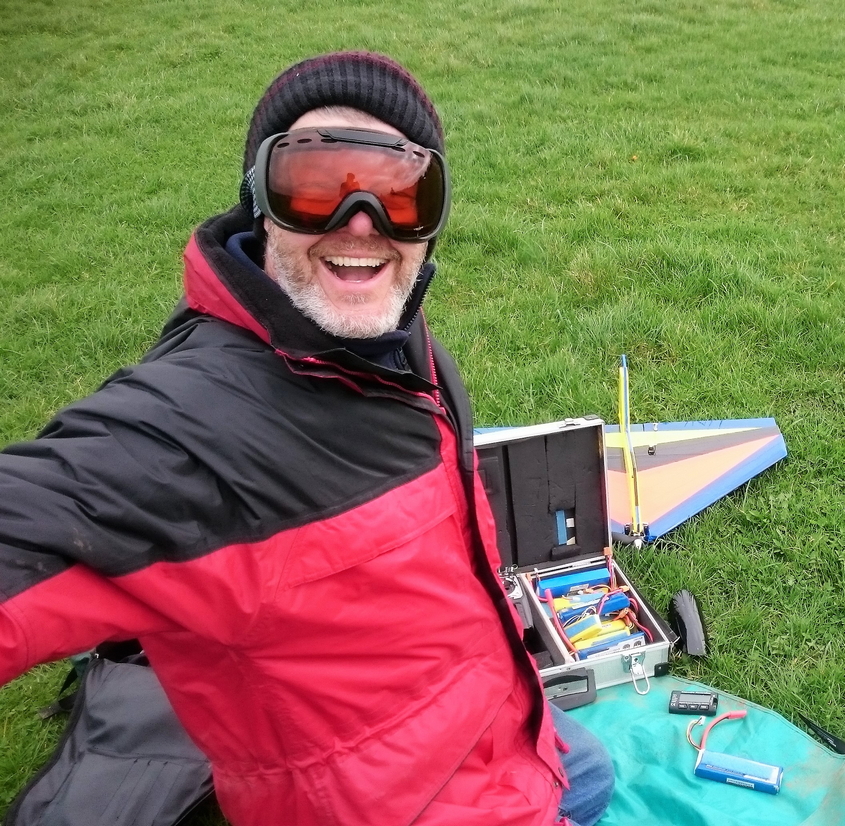 It’s a bit like FPV but rather than looking at a TV screen mounted inside goggles the user is looking at the model in the usual way but through the goggles. They use something called Polar Foil to display the information but they just looks like tinted goggles from the outside. The system seems to work very well and as you can see Steve loves it.
It’s a bit like FPV but rather than looking at a TV screen mounted inside goggles the user is looking at the model in the usual way but through the goggles. They use something called Polar Foil to display the information but they just looks like tinted goggles from the outside. The system seems to work very well and as you can see Steve loves it.
Time for another old photo now, not sure how long ago this was taken or what the event was but the hard hats make me think it was a pylon race competition. I was flying electric, my Two Fun-Eee, so it must have been within the last 22 years or so! How many can you name? Answers below the photo. Standing, left to right: Ken Boucher, Ian Hewlett, Don Eades, Mick Harper, Frank Buckland, Keith Garner, Den Figgins, Reg Street, Graham Head, Doreen Palmer, Don Hoolahan, Dave Rice. Kneeling, left to right: Mike Upton, Andy Palmer, Geoff Berry, Chas Butler.
Standing, left to right: Ken Boucher, Ian Hewlett, Don Eades, Mick Harper, Frank Buckland, Keith Garner, Den Figgins, Reg Street, Graham Head, Doreen Palmer, Don Hoolahan, Dave Rice. Kneeling, left to right: Mike Upton, Andy Palmer, Geoff Berry, Chas Butler.
Those of you that have been to the patch this month will be aware that I have bought another piece of incredibly useful technology (toy). You’ll be aware because it’s probably annoyed you with all the bleeping and talking! It’s a multi-function telemetry sensor, a UniSens–E made by SM Modellbau that simply plugs between the esc and lipo.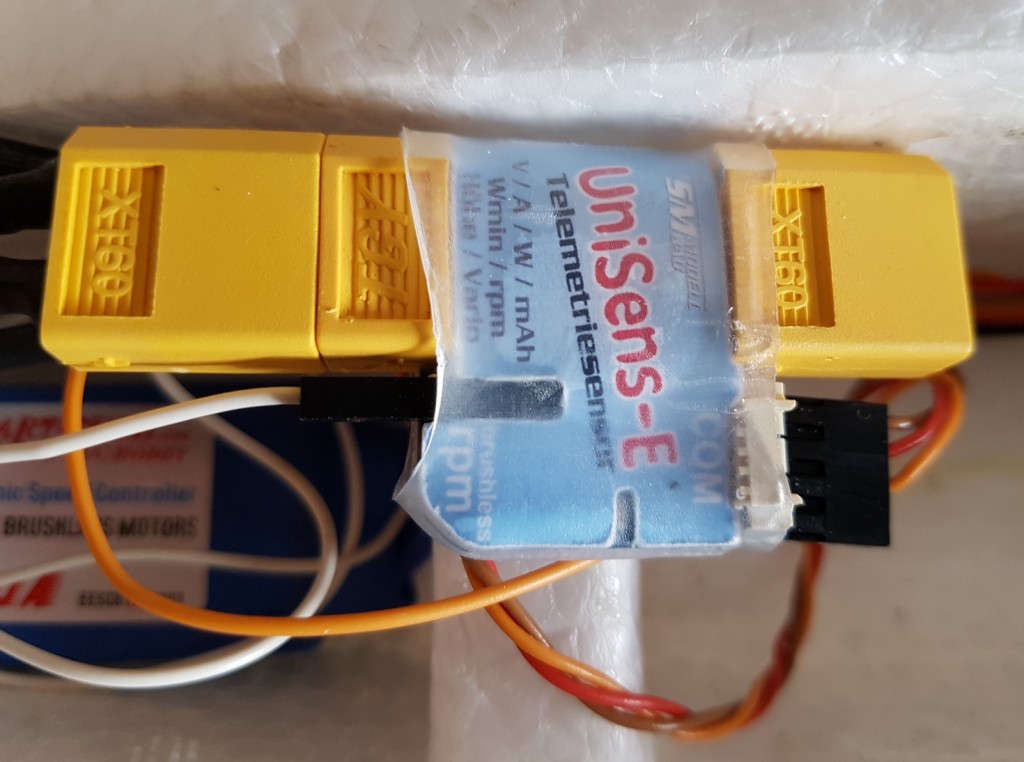 It will display on the transmitter screen and, if you wish, speak the same functions as the Multiplex current sensors that I sometimes use i.e. motor current, mAh consumed, and voltage reaching the receiver. But in addition it also senses the motor rpm, the lipo pack voltage, and it has a vario and an altimeter. The vario is similar to that used in full-size gliders, it beeps rising tones when the model is climbing, and descending tones when it’s sinking. The altimeter speaks the height of the model above the launch point in metres. There are many settings, alarms etc. that can be programmed and various things that can be switched on or off during the flight. The beeping of the vario can be a bit annoying after a while if it’s not actually being used for search out lift so I can switch it off if I want. I have been using it in my ASK-21 motor glider and after a few flights with the transmitter speaking every piece of info it was receiving I changed on it to just tell me how many mAh I had used from the battery, and the altitude.
It will display on the transmitter screen and, if you wish, speak the same functions as the Multiplex current sensors that I sometimes use i.e. motor current, mAh consumed, and voltage reaching the receiver. But in addition it also senses the motor rpm, the lipo pack voltage, and it has a vario and an altimeter. The vario is similar to that used in full-size gliders, it beeps rising tones when the model is climbing, and descending tones when it’s sinking. The altimeter speaks the height of the model above the launch point in metres. There are many settings, alarms etc. that can be programmed and various things that can be switched on or off during the flight. The beeping of the vario can be a bit annoying after a while if it’s not actually being used for search out lift so I can switch it off if I want. I have been using it in my ASK-21 motor glider and after a few flights with the transmitter speaking every piece of info it was receiving I changed on it to just tell me how many mAh I had used from the battery, and the altitude. By using a spare receiver channel it’s possible to switch between ‘live’ reading, max readings, or min readings. So I can fly around listening to the ‘live’ readings of how high I am, how much I’ve taken out of the battery, but can switch at any time to hear the maximum height I reached during the flight, even after I’ve landed, right up to the time I switch off the transmitter. I tried to video the screen and record the beeps and speech whilst flying but the quality was very poor so you are spared that little pleasure. But here’s a photo I took of the screen after I landed from one flight during which I went about as high as I dared.
By using a spare receiver channel it’s possible to switch between ‘live’ reading, max readings, or min readings. So I can fly around listening to the ‘live’ readings of how high I am, how much I’ve taken out of the battery, but can switch at any time to hear the maximum height I reached during the flight, even after I’ve landed, right up to the time I switch off the transmitter. I tried to video the screen and record the beeps and speech whilst flying but the quality was very poor so you are spared that little pleasure. But here’s a photo I took of the screen after I landed from one flight during which I went about as high as I dared.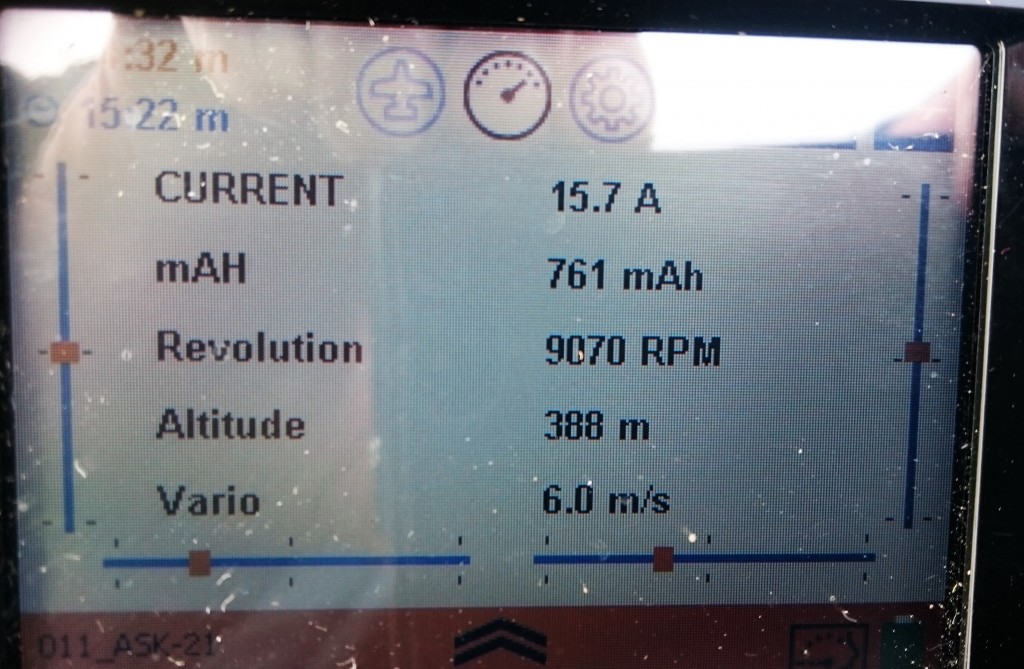 388 metres is 1273 feet, pretty high with a 2 metre span glider. The sensor will work with a variety of radio systems, not just Multiplex. So if you use Futaba, FR Sky, Jeti, Graupner, JR, or Spektrum (with an adaptor) that is telemetry compatible you too could use this very clever bit of kit. Note that it is not compatible with Hitec, presumably the Hitec operating system is very different and that’s why they have chosen to go for the HUD system that 1066 has purchased. Obviously the Unisens-E is most useful if your transmitter has speech capability but that’s not essential. It’s available with a variety of connectors, not just XT60’s and costs just 65 Euros.
388 metres is 1273 feet, pretty high with a 2 metre span glider. The sensor will work with a variety of radio systems, not just Multiplex. So if you use Futaba, FR Sky, Jeti, Graupner, JR, or Spektrum (with an adaptor) that is telemetry compatible you too could use this very clever bit of kit. Note that it is not compatible with Hitec, presumably the Hitec operating system is very different and that’s why they have chosen to go for the HUD system that 1066 has purchased. Obviously the Unisens-E is most useful if your transmitter has speech capability but that’s not essential. It’s available with a variety of connectors, not just XT60’s and costs just 65 Euros.
Apparently nobody spotted that the blurry photo in Patch News last month was of Dougal Entendre (AKA Mark Agate). It’s not really surprising, even his wife Angie didn’t recognise him! Perhaps this equally blurred photo of Dougal from a similar era will be more recognisable.
Judging by his nostrils it was taken during the coke snorting years!
I’m a bit short of material this month so I’ll show you what I’m building at the moment. It’s quite a while since I actually built a proper balsa model from a plan but this one shouldn’t tax me too much, it’s a 22” span Sharkface. It was a free plan in a recent RCM&E but was originally designed for single channel radio in 1965 by Eric Clutton. I was flying single channel models in1965 and remember the Sharkface very well. I didn’t build one but my flying mate Bill Carter did although I don’t remember how it flew. Bill’s was powered by a Cox 049 and used RCS Guidance System radio. Mine will be the updated version, electric powered of course, and will have an elevator and throttle, not just a rudder! It’s much further along than in the photo and I’m hoping to fly it on the first Sunday in April.
It was a free plan in a recent RCM&E but was originally designed for single channel radio in 1965 by Eric Clutton. I was flying single channel models in1965 and remember the Sharkface very well. I didn’t build one but my flying mate Bill Carter did although I don’t remember how it flew. Bill’s was powered by a Cox 049 and used RCS Guidance System radio. Mine will be the updated version, electric powered of course, and will have an elevator and throttle, not just a rudder! It’s much further along than in the photo and I’m hoping to fly it on the first Sunday in April.
Kryten has been busy taking quality photos again this month and I’ve included some below. They are Basher Bob’s now deceased Splob, Colin Cowplain’s Raptor, Dwayne Pipe with his glider, Basher’s Walrus, and finally Dwayne’s Spitfire dropping its undercarriage, great shots, thanks Kryten.
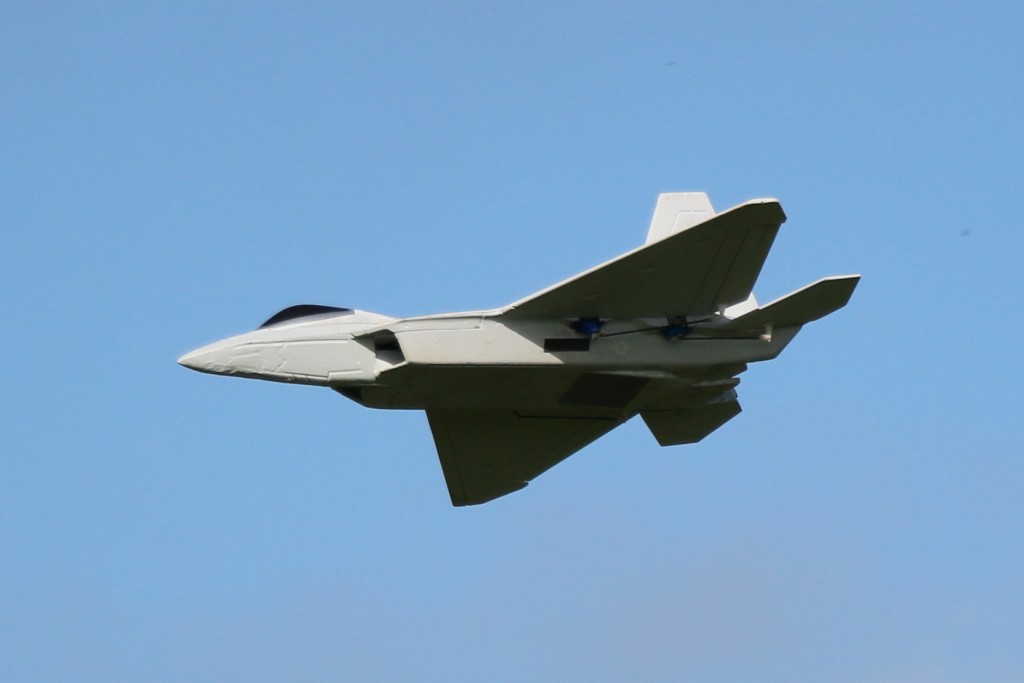


 OK, it’s time for this month’s video.Please watch the video full screen, it’s so much better with small models flying around. If the video above won’t play for you CLICK HERE
OK, it’s time for this month’s video.Please watch the video full screen, it’s so much better with small models flying around. If the video above won’t play for you CLICK HERE
No joke this month, instead I leave you with a couple of photos. Woody decided he owed me a favour and ordered a couple of printed T-shirts, one for each of us. They pay homage to Woody’s favourite film!
 Thanks Woody…I think!
Thanks Woody…I think!
Colin Cowplain

